Mardi Gras Decoration
What Is a Popular New Orleans Drink?
In New Orleans, the city’s famous beverages flow freely just like the Mississippi River on a hot summer day. The vibrant culture and deep history of this city have inspired some of the most distinctive and cherished cocktails in the world.
From the famous Hurricane to the mysterious Vieux Carré, there's a drink for every palate in the Big Easy. But what exactly makes these drinks so special, and where can one find the best places to experience them?
Stay tuned as we uncover the secrets behind the popular New Orleans libations and where to savor them in their true element.
Key Takeaways
- The Sazerac, Hurricane, Ramos Gin Fizz, and Vieux Carré are some of the most popular drinks in New Orleans.
- These drinks are made with signature ingredients such as rye whiskey, absinthe, rum, fruit juice, and various liqueurs.
- Notable bars and restaurants in New Orleans, such as Pat O'Brien's, Lafitte's Blacksmith Shop, and the Carousel Bar & Lounge, are known for serving these iconic cocktails.
- New Orleans' cocktails have cultural and historical significance, representing the city's diverse influences and contributing to its vibrant food and cocktail scene.
The History of New Orleans Cocktails
The history of New Orleans cocktails dates back to the early 19th century, intertwining with the city's rich cultural tapestry and culinary heritage. One of the most iconic cocktails to emerge from this vibrant concoction of influences is the Sazerac. Its evolution showcases the innovative spirit that characterizes New Orleans' cocktail culture.
The Sazerac, believed to be one of the world's oldest cocktails, originated in the 1830s, making it a true testament to the city's pioneering role in cocktail innovation.
The Sazerac's evolution reflects the dynamic nature of New Orleans' cocktail scene. From its humble beginnings as a medicinal concoction to its current status as a revered classic, the Sazerac has undergone several transformations while remaining deeply rooted in the city's history. This cocktail's journey mirrors the broader narrative of cocktail innovation in New Orleans, where creativity and tradition intersect to produce timeless libations.
The intricate tale of New Orleans cocktails is a testament to the city's enduring legacy as a cradle of mixology, where each sip offers a glimpse into the rich tapestry of its spirited past.
The Iconic Hurricane
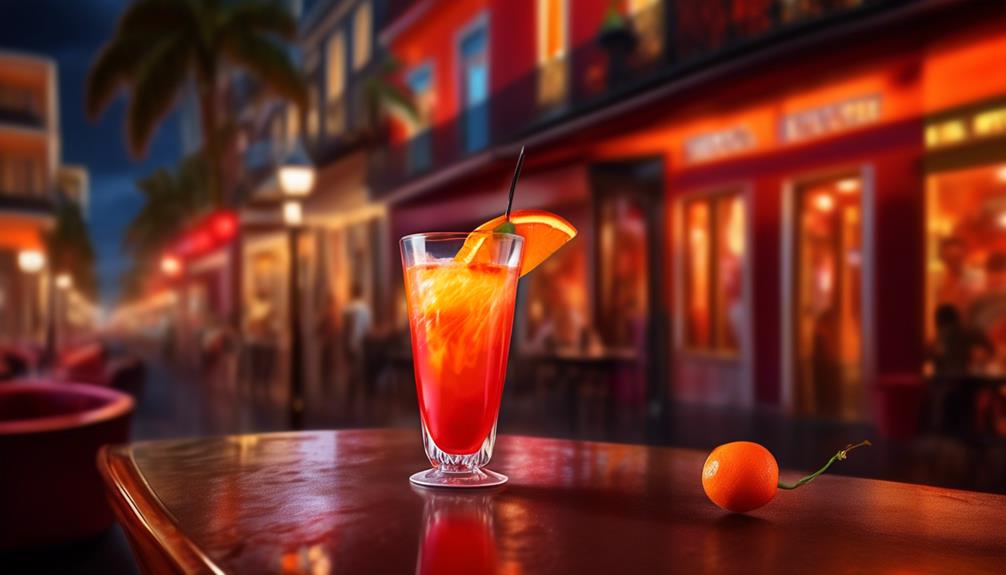
One of the most iconic cocktails to emerge from the rich cocktail culture of New Orleans is the Hurricane, a drink that holds a significant place in the city's spirited legacy. The Hurricane cocktail originated at Pat O'Brien's bar in the 1940s and has since become a symbol of the vibrant and indulgent essence of New Orleans. This delectable concoction is typically made with rum, fruit juice, and syrup, delivering a sweet yet potent punch that has made it a favorite among locals and visitors alike.
To provide a glimpse into the diverse world of Hurricane variations and the popular bars where this iconic drink can be enjoyed, take a look at the table below:
| Popular Hurricane Bars | Hurricane Variations |
|---|---|
| Pat O'Brien's (French Quarter) | Classic Hurricane |
| Lafitte's Blacksmith Shop (French Quarter) | Passion Fruit Hurricane |
| The Carousel Bar & Lounge at Hotel Monteleone | Mango Hurricane |
| Beachbum Berry's Latitude 29 | Pineapple Hurricane |
| Tiki Tolteca | Strawberry Hurricane |
These bars offer an authentic New Orleans experience and showcase the unique variations of the Hurricane, allowing patrons to savor the rich history and delightful flavors of this iconic cocktail.
Exploring the Classic Sazerac
Let's journey back to the 19th century, when the Sazerac first made its mark in the historic city of New Orleans. Originating as a medicinal elixir, this iconic cocktail has stood the test of time, evolving into a beloved classic.
With its unique blend of rye whiskey, absinthe, bitters, and a touch of sugar, the Sazerac continues to be a staple in the Big Easy's vibrant cocktail culture.
Sazerac History
In the heart of New Orleans, a timeless cocktail with a rich history and enduring legacy is the Sazerac.
The origins of the Sazerac date back to the 19th century, where it was crafted with Sazerac brandy, absinthe, Peychaud's Bitters, and a sugar cube. Over time, variations of the Sazerac emerged, with some using rye whiskey as the base instead of brandy, while others incorporate different types of bitters or even substitute absinthe with other anise-flavored liqueurs.
The Sazerac has become a symbol of New Orleans' cocktail culture, embodying the city's unique blend of French, American, and Creole influences. Its enduring popularity is a testament to its exquisite balance and deep roots in the city's vibrant history.
Sazerac Recipe
The classic Sazerac recipe traces its origins to the 19th century, featuring a harmonious blend of Sazerac brandy or rye whiskey, absinthe, Peychaud's Bitters, and a sugar cube.
When crafting this iconic cocktail, mixology techniques play a pivotal role. The key lies in the careful muddling of the sugar cube with Peychaud's Bitters, followed by the addition of the Sazerac brandy or rye whiskey. This process ensures a balanced infusion of flavors, creating a rich and aromatic base.
The use of absinthe to coat the serving glass adds an alluring depth to the drink's flavor profile, enhancing its complexity.
In New Orleans, where cocktail culture thrives, serving traditions dictate that the Sazerac is traditionally presented in an Old Fashioned glass, emphasizing the drink's historical significance and timeless appeal.
The Refreshing Ramos Gin Fizz
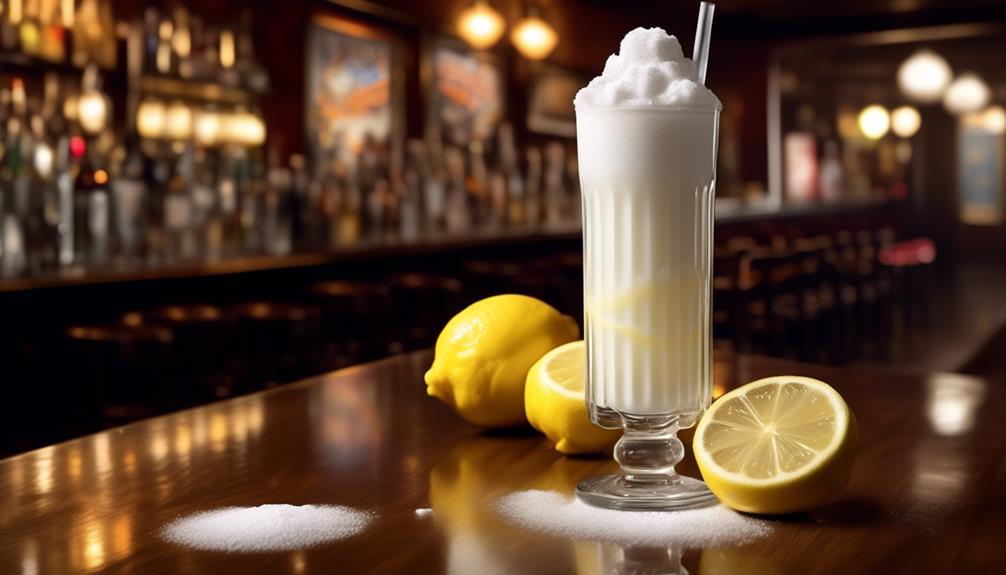
Let's talk about the refreshing Ramos Gin Fizz.
This classic cocktail has a fascinating history and origin, dating back to the late 1800s in New Orleans.
Its signature ingredients, including gin, lemon juice, sugar, cream, and orange flower water, create a delightful and frothy concoction that has stood the test of time.
Classic Cocktail Recipe
For aficionados of classic cocktails, one libation that stands the test of time and continues to captivate the discerning palate is the refreshing Ramos Gin Fizz. This iconic cocktail has a rich history, dating back to the late 1800s in New Orleans.
The recipe for a perfect Ramos Gin Fizz involves a meticulous blend of ingredients and precise mixology techniques. Here's how to create this timeless delight:
- Combine 2 oz gin, 1/2 oz fresh lemon juice, 1/2 oz fresh lime juice, 1 oz simple syrup, 3 drops of orange flower water, 1 egg white, and 2 oz heavy cream in a shaker without ice.
- Shake vigorously for at least a minute to emulsify the ingredients.
- Add ice to the shaker and shake again until well chilled.
This classic cocktail, with its frothy texture and citrusy sweetness, is a true masterpiece of mixology.
History and Origin
Originating in the vibrant city of New Orleans in the late 1800s, the refreshing Ramos Gin Fizz has a rich and storied history that has captivated cocktail enthusiasts for generations.
Its origin and evolution are deeply rooted in the cultural significance of the city's renowned cocktail scene. Created by Henry C. Ramos, the drink gained immense popularity at the Imperial Cabinet Saloon, where it became an iconic representation of New Orleans' mixology.
The evolution of the Ramos Gin Fizz reflects the city's dynamic cultural melting pot, blending influences from French, Spanish, African, and American traditions.
This delightful concoction has stood the test of time, maintaining its allure through the decades. Its history is a testament to the enduring legacy of New Orleans' cocktail culture and its profound impact on the art of mixology.
Signature Ingredients
What are the key ingredients that give the Refreshing Ramos Gin Fizz its distinctive and timeless flavor?
The signature flavors of this iconic New Orleans drink are a carefully selected combination of ingredients that have stood the test of time. The popular variations of the Ramos Gin Fizz may have slight tweaks, but the classic recipe remains unchanged.
Here are the essential components that contribute to its unique taste:
- Gin: A smooth and aromatic base spirit that forms the backbone of the cocktail.
- Fresh lemon juice: Adds a tangy and citrusy kick, balancing the sweetness of the other ingredients.
- Cream and egg white: These ingredients create the frothy, velvety texture that sets the Ramos Gin Fizz apart from other cocktails.
These elements harmonize to produce a refreshing and indulgent beverage that has delighted drinkers for generations.
The Mysterious Vieux Carré

Steeped in the rich history of New Orleans, the Vieux Carré cocktail embodies the spirit of the city's vibrant culture and heritage. This iconic drink has deep roots in the cocktail culture of New Orleans and is a cherished tradition in the city's mixology scene. Created in the 1930s at the famed Carousel Bar, the Vieux Carré has stood the test of time, maintaining its popularity amidst evolving mixology trends.
The Vieux Carré is a complex and intriguing concoction, reflecting the diverse influences that have shaped New Orleans. Its blend of rye whiskey, cognac, and sweet vermouth, along with dashes of herbal liqueur and aromatic bitters, creates a symphony of flavors that dance on the palate. This timeless libation pays homage to the French and Creole heritage of the city, capturing the essence of its historic French Quarter, also known as the Vieux Carré.
Today, the Vieux Carré remains an integral part of New Orleans' drinking culture, celebrated by locals and visitors alike. Its enigmatic allure and timeless appeal continue to make it a revered symbol of the city's rich cocktail tradition.
Unraveling the Mystique of Absinthe Frappé
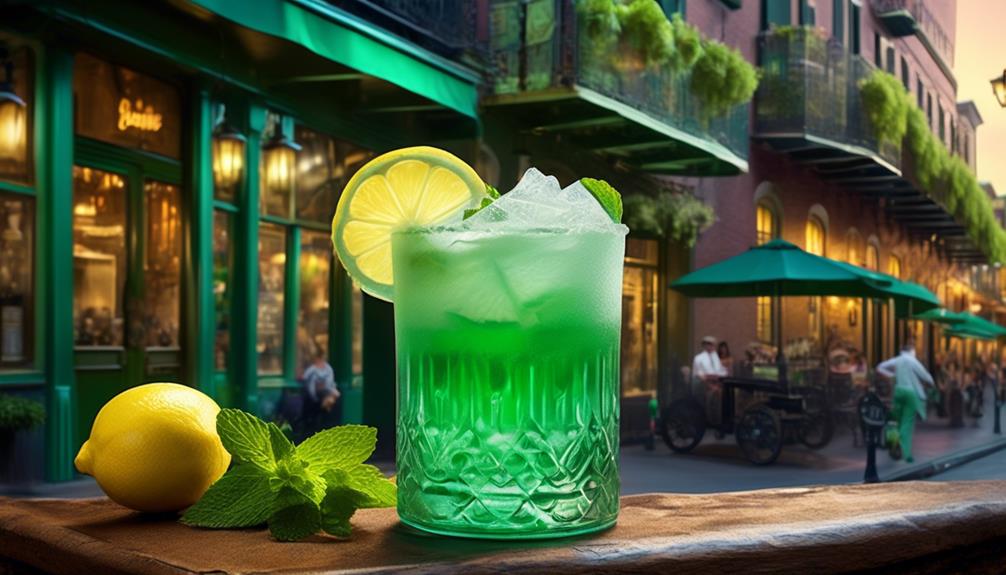
Unveiling the allure and historical significance of Absinthe Frappé reveals a fascinating journey through the annals of cocktail culture in New Orleans. Absinthe, with its storied past and deep ties to the city, has long been a key player in the vibrant tapestry of New Orleans' libations. When it comes to the enigmatic world of absinthe culture, the Absinthe Frappé stands out as a timeless classic, capturing the essence of the Green Fairy in a refreshing and invigorating drink.
Here are a few insights into the world of Absinthe Frappé:
- Origins: The Absinthe Frappé is believed to have originated in the late 19th century, gaining popularity in the iconic bars of New Orleans. Its creation is often attributed to Cayetano Ferrer, a renowned mixologist at the time.
- Preparation: The preparation of Absinthe Frappé involves the careful blending of absinthe, sugar, and fresh mint, all shaken with crushed ice to achieve a frosty, minty delight.
- Frappé Variations: Over the years, mixologists have put their own spin on the classic Absinthe Frappé, introducing variations that incorporate different herbs, fruits, and even flavored syrups, adding new dimensions to this beloved concoction.
The Absinthe Frappé continues to evoke the enchanting spirit of New Orleans' cocktail culture, inviting aficionados to savor its timeless allure and explore its diverse frappé variations.
The Unique Flavors of Pimm's Cup
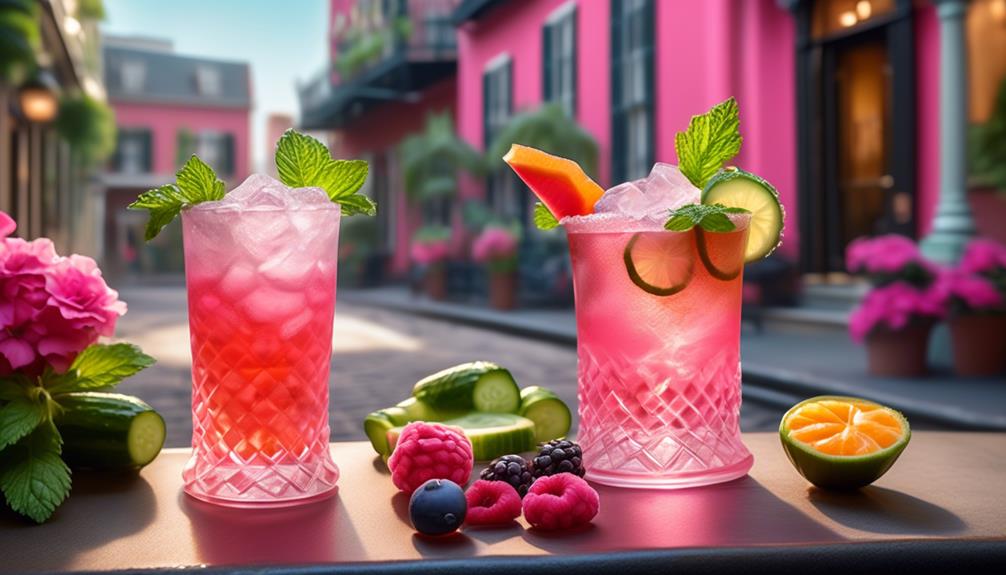
The Absinthe Frappé, an iconic fixture of New Orleans' cocktail culture, paves the way for our exploration of the distinct and refreshing flavors of Pimm's Cup. Pimm's Cup, a beloved beverage in the city, has evolved over time, leading to a plethora of variations that showcase the creativity of modern mixology techniques.
The traditional Pimm's Cup features Pimm's No. 1, a gin-based liqueur, mixed with lemonade or ginger ale, and garnished with fruits and herbs. However, contemporary bartenders have introduced innovative twists to this classic concoction. Variations may include the addition of fresh muddled fruits, artisanal syrups, or even a hint of spice for a modern touch. These adaptations elevate the drink's complexity while preserving its refreshing nature.
In the heart of New Orleans, one can expect to find a diverse array of Pimm's Cup interpretations, each reflecting the individual flair of the establishments and mixologists. Whether it's served over crushed ice or with a playful garnish, the varying renditions of Pimm's Cup offer a delightful journey through the city's vibrant and ever-evolving cocktail scene.
The Sweet and Bitter French 75
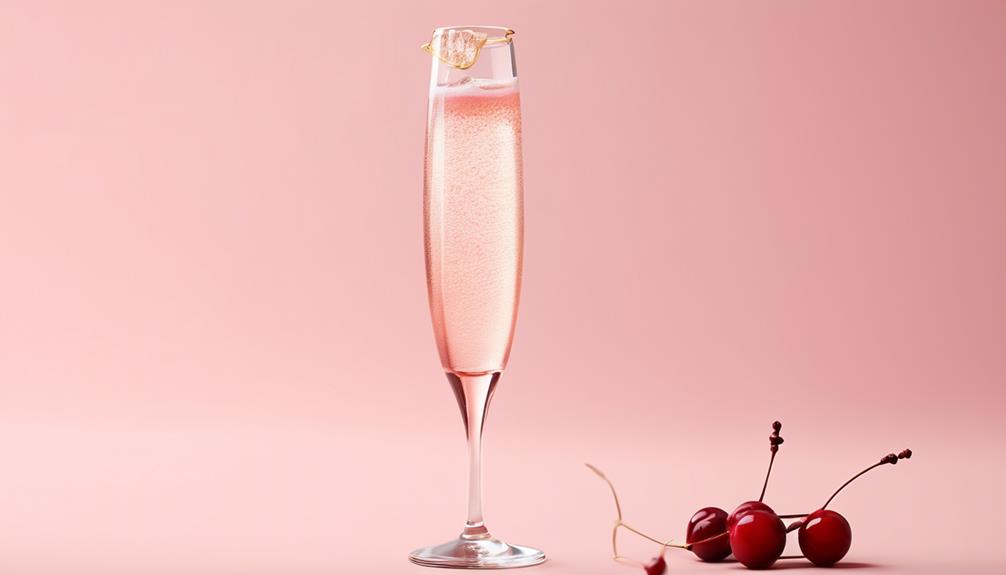
We adore the timeless allure of the French 75, a cocktail that seamlessly blends sweet and bitter notes. Its classic recipe dates back to the early 1900s, and it has remained a staple in New Orleans' vibrant cocktail scene.
The historical significance of this libation is undeniable, making it a must-try for anyone seeking a taste of the city's rich drinking culture.
Classic Cocktail Recipe
In the early 20th century, the Sweet and Bitter French 75 cocktail emerged as a timeless classic, blending gin, lemon juice, simple syrup, and Champagne to create a delightful and refreshing libation. This iconic cocktail has stood the test of time, delighting patrons with its perfect balance of sweet and tangy flavors.
The classic recipe for a French 75 includes:
- 2 ounces of gin
- 3/4 ounce of fresh lemon juice
- 1/2 ounce of simple syrup
- 2 ounces of Champagne
Cocktail variations abound, with some opting for cognac in place of gin or adding a splash of elderflower liqueur for a modern twist. Different serving styles also add to the allure of the French 75, whether it's served in a traditional champagne flute or a sleek coupe glass.
This beloved libation continues to captivate cocktail enthusiasts with its timeless appeal.
Historical Significance
Emerging from the cocktail renaissance of the early 20th century, the Sweet and Bitter French 75 has etched its place in history as an enduring and beloved libation, captivating patrons with its perfect blend of gin, lemon juice, simple syrup, and Champagne.
Its historical significance is profound, as it reflects the cultural impact of an era characterized by elegance, sophistication, and the zest for life. The Sweet and Bitter French 75 embodies the spirit of the Roaring Twenties, a time of celebration, innovation, and liberation. Its popularity soared during Prohibition, becoming a symbol of defiance and indulgence.
This iconic cocktail continues to enchant modern audiences, transporting them back to an era of glamour and revelry. Its historical significance and cultural impact endure, making it a timeless favorite among cocktail aficionados.
The Allure of the Brandy Milk Punch
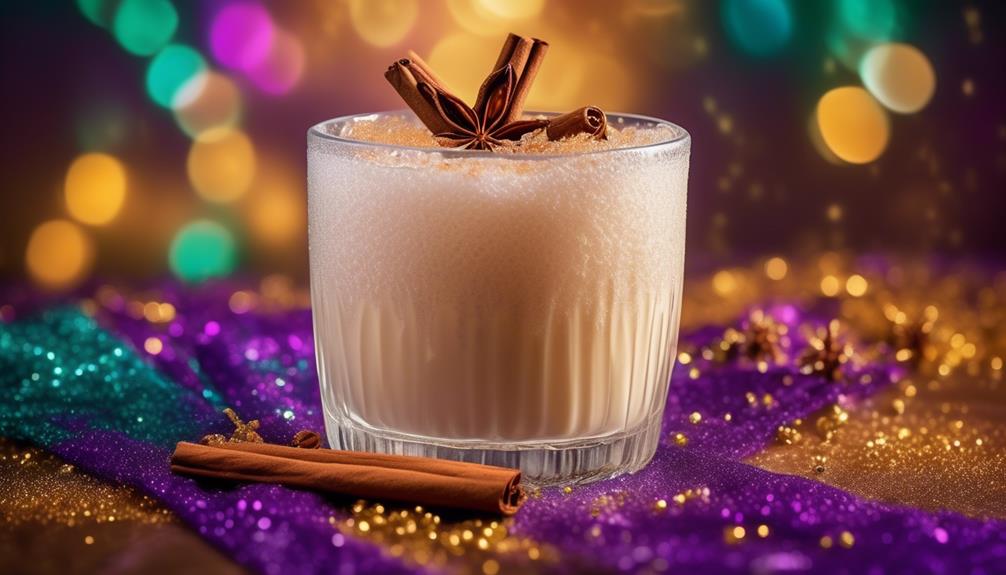
The allure of Brandy Milk Punch lies in its rich history and its timeless appeal as a classic New Orleans libation. This traditional recipe has been savored for centuries, evolving through the ages to adapt to modern variations while still retaining its essence. The popular bars of New Orleans have long been the guardians of this cherished concoction, each adding their own unique flavors to the mix, enriching the city's vibrant cocktail culture.
- Historical Significance: The Brandy Milk Punch has been a staple in New Orleans since the 19th century, enjoyed by both locals and visitors alike.
- Traditional Recipe: The original recipe consists of brandy, milk, powdered sugar, vanilla extract, and a sprinkle of nutmeg, creating a creamy and indulgent elixir.
- Modern Variations: While the traditional recipe remains beloved, modern mixologists have introduced innovative twists, incorporating ingredients like spiced syrups or flavored liqueurs to elevate the drink to new heights.
The Brandy Milk Punch encapsulates the spirit of New Orleans, blending history, tradition, and innovation into a single, delightful libation. Its allure isn't just in its taste, but in the stories and memories it carries, making it a cherished part of New Orleans' rich cultural tapestry.
The Signature Go-Cup Culture
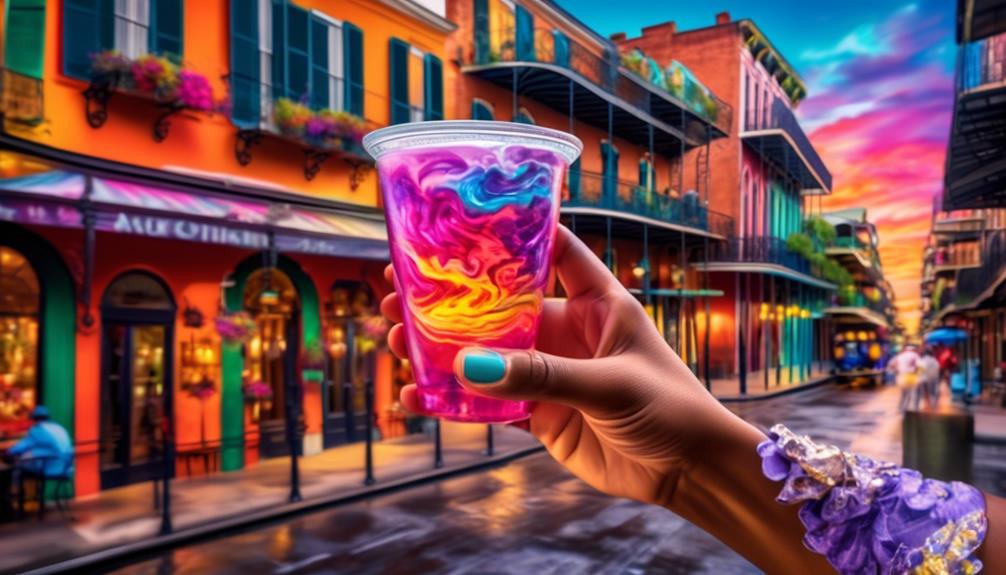
As we savor the allure of the Brandy Milk Punch, we find ourselves immersed in the vibrant culture of New Orleans, where the iconic go-cup has become a symbol of the city's laissez-faire attitude towards enjoying libations on the go.
The tradition of the go-cup dates back to the 1980s when the city legalized the consumption of alcoholic beverages on the streets within certain boundaries. This liberation led to the birth of a unique street drinking culture, where locals and visitors alike could stroll through the historic French Quarter with their favorite cocktails in hand.
The go-cup etiquette is a revered aspect of New Orleans' social fabric. It's customary to respect the community by not littering and to be mindful of others while indulging in the revelry of street-side imbibing.
As dusk settles over the city, the streets come alive with the sounds of jazz, laughter, and the clinking of plastic go-cups. This distinctive practice has become an essential part of the city's identity, allowing individuals to enjoy the rich tapestry of New Orleans' music, cuisine, and hospitality while embracing the freedom of the go-cup culture.
Discovering the Nostalgic Grasshopper

Indulging in the nostalgic Grasshopper cocktail, one experiences the rich heritage and flavors embedded in New Orleans' famous libations. The Grasshopper, with its creamy mint-chocolate goodness, has been a beloved fixture in the city's cocktail scene for decades, offering a taste of old-world charm and indulgence.
As we explore this iconic drink, we uncover the following:
- Historical Significance: The Grasshopper has a storied past, believed to have been created in the 1920s at a French Quarter bar. Its enduring popularity speaks to its deep roots in New Orleans' cocktail culture.
- Unique Flavors: The cocktail's harmonious blend of crème de menthe, white crème de cacao, and cream creates a decadent, dessert-like experience that sets it apart from other nostalgic cocktails.
- Cultural Influence: The Grasshopper's influence extends beyond its delectable taste, intertwining with the city's vibrant history and social life, making it a symbol of conviviality and celebration.
The Grasshopper embodies the essence of New Orleans, offering a glimpse into the city's rich past and the unique flavors that have delighted locals and visitors alike for generations.
The Influence of Hand Grenade

Amidst the bustling cocktail scene of New Orleans, the Grasshopper's influence is palpable, and it is in this spirited environment that the Hand Grenade made its mark as a formidable contender. The Hand Grenade's popularity soared due to its unique blend of flavors and distinctive, grenade-shaped container. This iconic drink has had a profound cultural impact, becoming synonymous with the vibrant spirit of Bourbon Street. Its neon green hue and catchy slogan "The Most Powerful Drink in New Orleans" became ingrained in the city's folklore. The marketing strategies for the Hand Grenade, including its exclusive availability at Tropical Isle, contributed to its allure. The drink's widespread popularity is evident in the countless souvenir shops proudly displaying Hand Grenade-themed merchandise.
| Cultural Impact | Hand Grenade Popularity | Marketing Strategies |
|---|---|---|
| Became iconic | Soared in popularity | Exclusive availability |
| Synonymous with Bourbon Street | Ingrained in city folklore | Catchy slogan |
| Emblematic of New Orleans vibrancy | Countless souvenir shops | Unique container design |
The Hand Grenade is a testament to the way a drink can become more than a beverage, transcending into a symbol of a city's lively and unapologetic spirit.
Where to Find New Orleans Drinks
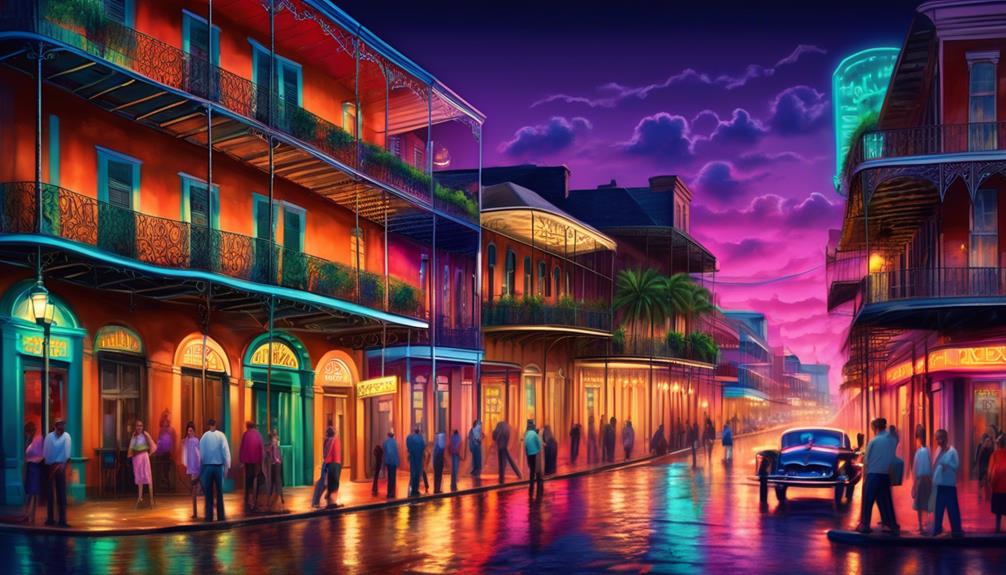
In our quest to discover the authentic New Orleans drinks, one can find an array of iconic beverages served in historic bars, renowned restaurants, and vibrant street-side establishments.
When seeking the best bars to sample local favorites, one must visit the historic Napoleon House, where the Pimm's Cup has been enjoyed for over a century.
Another must-visit is the elegant Carousel Bar at Hotel Monteleone, famous for its Vieux Carré cocktail and revolving carousel seating.
For a more laid-back experience, the beloved Pat O'Brien's courtyard is the perfect spot to savor their signature Hurricane cocktail while enjoying live music.
Lastly, no search for New Orleans drinks would be complete without a visit to Lafitte's Blacksmith Shop, the oldest bar in the country, known for its potent and mysterious Voodoo Daiquiri.
These establishments not only serve up the best drinks but also offer a glimpse into the rich history and culture of this vibrant city.
Frequently Asked Questions
What Are Some Non-Alcoholic Drinks Popular in New Orleans?
Some popular non-alcoholic drinks in New Orleans include refreshing mocktail options like the classic Mint Julep mocktail and the zesty Hurricane mocktail, which are inspired by the city's vibrant beverage culture.
New Orleans has a rich tradition of crafting flavorful non-alcoholic beverages to cater to all tastes, from sweet and fruity concoctions to tangy and herbal infusions.
These mocktails offer a delightful way to savor the city's unique beverage culture.
Are There Any Specific Drinking Traditions or Customs Associated With New Orleans Cocktails?
Drinking traditions in New Orleans have deep cultural significance, often tied to celebrations and community gatherings. The city's cocktails, like the Sazerac and Hurricane, are steeped in history and reflect the unique blend of influences that define New Orleans.
From toasting at Mardi Gras to sipping a cocktail at a jazz club, the act of imbibing is intertwined with the city's spirit. These customs continue to shape the vibrant social fabric of New Orleans.
What Are Some Lesser-Known or Underrated New Orleans Drinks That Visitors Should Try?
When it comes to signature cocktails in New Orleans, there are hidden gems that visitors should definitely try. These lesser-known drinks often hold a rich historical significance and offer a unique taste of the city's culture.
From the refreshing Ramos Gin Fizz to the complex Vieux Carré, there are plenty of underrated options waiting to be discovered.
Exploring these lesser-known drinks adds an authentic and intimate touch to the New Orleans experience.
Are There Any Local Ingredients or Unique Flavors That Are Commonly Used in New Orleans Cocktails?
Local ingredients and unique flavors are integral to New Orleans cocktails. Mixology techniques here reflect our city's rich history and diverse culture.
From the use of indigenous herbs and spices to the incorporation of tropical fruits, our cocktails capture the essence of the region.
Cocktail trends in New Orleans often celebrate the fusion of traditional and modern flavors, creating a truly unique drinking experience that pays homage to our vibrant culinary heritage.
Can You Recommend Any Specific Bars or Restaurants in New Orleans Known for Their Exceptional Cocktail Offerings?
We've discovered some remarkable speakeasy bars and hidden gems in New Orleans, where craft cocktail trends and mixology expertise shine.
These establishments, like *insert bar/restaurant name*, are known for their exceptional cocktail offerings. From classic concoctions to innovative creations, these places boast a rich history and an intimate ambiance, making them must-visit destinations for cocktail enthusiasts.
Get ready to embark on a journey through time and flavor at these unique spots.
Conclusion
As we sip on the iconic Hurricane, let's reflect on the intricate history of New Orleans cocktails.
Each drink tells a story of the city's rich cultural heritage, from the classic Sazerac to the refreshing Ramos Gin Fizz.
Just like the layers of flavors in a Vieux Carré, the drinks of New Orleans offer a complex and intriguing experience.
So, next time you visit, be sure to indulge in the city's signature go-cup culture and discover the nostalgic Grasshopper.
Cheers to the spirit of New Orleans!
- About the Author
- Latest Posts
Introducing Ron, the home decor aficionado at ByRetreat, whose passion for creating beautiful and inviting spaces is at the heart of his work. With his deep knowledge of home decor and his innate sense of style, Ron brings a wealth of expertise and a keen eye for detail to the ByRetreat team.
Ron’s love for home decor goes beyond aesthetics; he understands that our surroundings play a significant role in our overall well-being and productivity. With this in mind, Ron is dedicated to transforming remote workspaces into havens of comfort, functionality, and beauty.
Mardi Gras Decoration
What Is the Religious Significance of Mardi Gras?

Mardi Gras, resembling a vibrant tapestry interwoven with tradition and spirituality, carries a more profound religious meaning than commonly depicted in mainstream culture. Despite the association of Mardi Gras with extravagant parades, colorful costumes, and lively parties, there exists a deep historical background and religious symbolism that form the foundation of this festive event.
As we explore the origins of Mardi Gras and its Christian roots, we will uncover the deeper layers of meaning behind this annual event, shedding light on its religious observances and spiritual reflections that continue to shape its practices today.
Key Takeaways
- Mardi Gras originated from the Christian tradition of feasting before Lent and is deeply rooted in the Christian celebration of Lent.
- Fat Tuesday symbolizes excess and indulgence before the fasting and penitential practices of Lent, serving as a reminder of the need for balance and spiritual growth.
- Mardi Gras marks the transition from indulgence to introspection in preparation for Lent and encourages individuals to reflect on their spiritual journey and make personal sacrifices.
- Mardi Gras is intricately linked to the religious fasting tradition observed during Lent and serves as the final day of indulgence before the solemn observance of Lent.
Origins of Mardi Gras
Mardi Gras, with its origins dating back to medieval Europe, is a festive celebration that carries deep religious and cultural significance. The origins of Mardi Gras can be traced to ancient pagan celebrations such as the Roman festivals of Saturnalia and Lupercalia, as well as the medieval Christian tradition of feasting before the Lenten fast. Over time, these diverse influences merged to form the modern-day Mardi Gras.
Culturally, Mardi Gras represents a culmination of various traditions brought to the United States by French and Spanish settlers in the 18th century. The celebration evolved to include elements of masquerade balls, street processions, and lavish feasting. This cultural amalgamation has contributed to the rich tapestry of Mardi Gras, making it an important part of the cultural heritage of New Orleans and other regions with strong ties to French and Spanish colonial history.
The religious significance of Mardi Gras is closely tied to its origins as a Christian festival marking the last day before the fasting period of Lent. It's a time of revelry and indulgence before the solemnity of the Lenten season, emphasizing the contrast between worldly pleasures and spiritual discipline. This duality is at the heart of the religious symbolism of Mardi Gras, making it a complex and deeply meaningful celebration.
Christian Roots
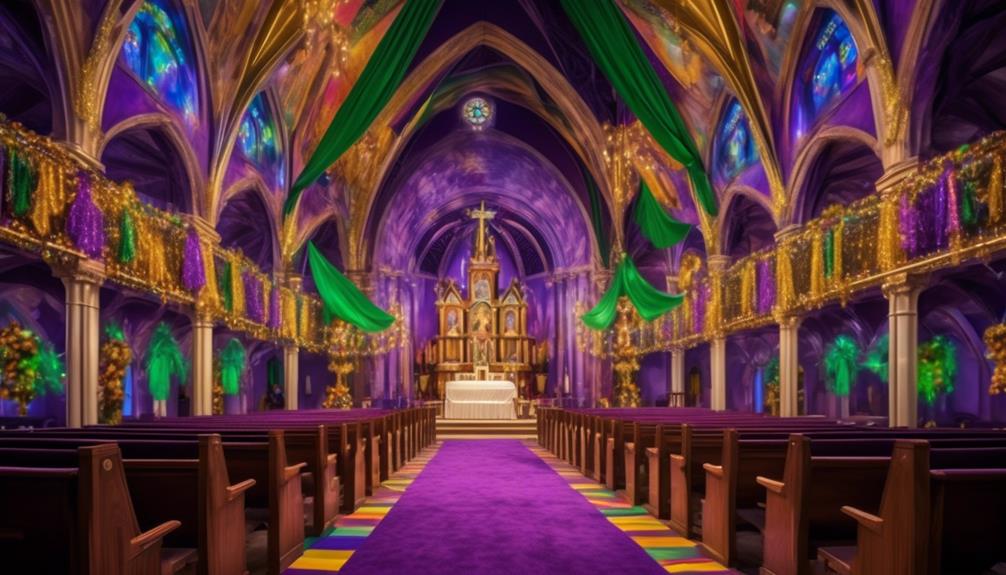
Examining the religious significance of Mardi Gras requires delving into its Christian roots, which provide insights into the festival's historical and spiritual underpinnings. Mardi Gras, also known as Shrove Tuesday or Fat Tuesday, is deeply rooted in the Christian celebration of Lent. Its historical significance lies in its role as the culmination of the Carnival season, a period of revelry and indulgence before the solemnity of Lent.
In Christian tradition, Lent is a time of penance, reflection, and preparation for the Easter season, and Mardi Gras serves as a final opportunity for merrymaking before the observance of Lenten disciplines.
The Christian roots of Mardi Gras are evident in the religious practices and customs associated with the festival. Across many Christian denominations, Mardi Gras is observed with various rituals and ceremonies, such as the consumption of rich and indulgent foods, symbolizing the last moments of feasting before the fasting period of Lent begins. These traditions have been passed down through generations, contributing to the enduring historical significance of Mardi Gras as a Christian celebration.
Understanding the Christian roots of Mardi Gras provides a deeper appreciation for its historical and spiritual dimensions, enriching the overall experience of this festive occasion.
Shrove Tuesday Tradition
The tradition of Shrove Tuesday, also known as Pancake Day, has its origins in the Christian tradition of using up rich foods like eggs and milk before the fasting period of Lent. The word 'shrove' comes from the old English word 'shrive,' which means to confess. On this day, people confess their sins and receive absolution before the Lenten season begins.
The tradition of Shrove Tuesday has evolved over time, and today it's celebrated in various ways around the world. Some common customs include indulging in pancakes, participating in pancake races, and coming together for a community feast.
Pancake Races are a popular tradition in some communities. Participants race while flipping pancakes in a pan. This lighthearted and fun activity is a way to celebrate Shrove Tuesday and enjoy the last day of indulgence before the Lenten fast.
Many churches and community organizations host feasts or pancake breakfasts on Shrove Tuesday. These gatherings provide an opportunity for people to come together and enjoy a meal before the solemn period of Lent begins.
The act of consuming pancakes and engaging in communal activities on Shrove Tuesday symbolizes a sense of togetherness, indulgence, and preparation for the upcoming period of reflection and abstinence during Lent.
Symbolism of Fat Tuesday
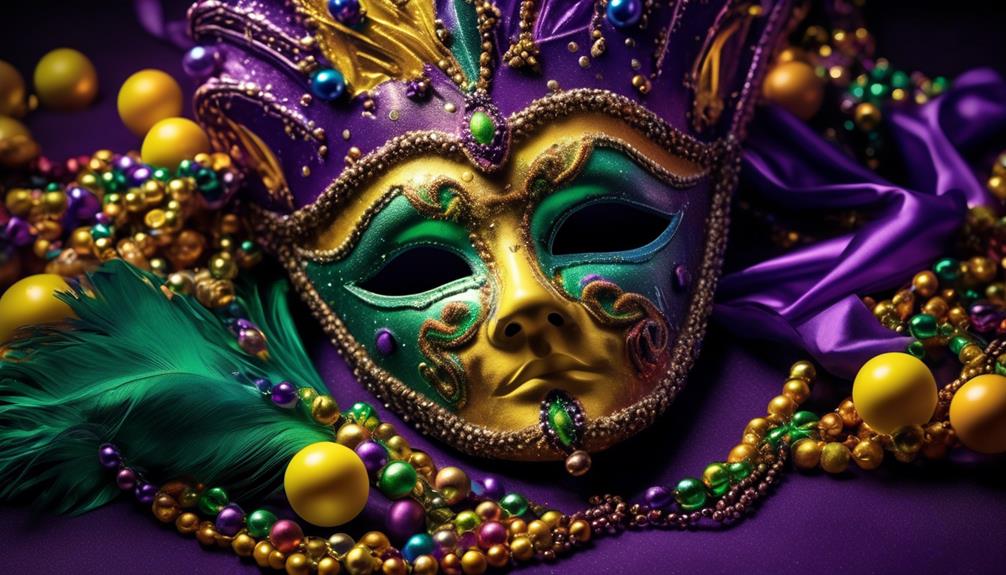
Fat Tuesday, also known as Mardi Gras, holds significant religious symbolism in its emphasis on excess and indulgence before the solemn period of Lent. This symbolism is rooted in the Christian tradition of preparing for the fasting and penitential practices of Lent by engaging in a day of feasting and revelry.
Understanding the religious significance of this day provides insights into the spiritual significance of the Mardi Gras celebration and its role in the broader context of the Christian liturgical calendar.
Religious Symbolism of Excess
In the religious context, Mardi Gras serves as a symbolic culmination of indulgence and excess before the solemn observance of Lent. This symbolism of excess holds religious significance, representing the need to engage in excessive celebration before the period of fasting and abstinence. It's a time to revel in earthly pleasures and worldly delights before turning inward and focusing on spiritual growth.
The religious symbolism of excess during Mardi Gras can be understood through the following aspects:
- Carnival Revelry: The excessive celebration during Mardi Gras signifies a temporary release from the constraints of everyday life.
- Feasting and Feasting: Indulging in rich and decadent foods symbolizes the enjoyment of earthly pleasures before the spiritual discipline of Lent.
- Extravagant Parades and Masquerades: The elaborate displays and disguises reflect the temporary abandonment of inhibitions and social norms, emphasizing the need for spiritual renewal.
This brief period of lavishness and revelry serves as a reminder of the balance between earthly pleasures and spiritual devotion.
Spiritual Preparation for Lent
The spiritual significance of Fat Tuesday lies in its role as a transitional period, marking the shift from indulgence to introspection in preparation for the Lenten season.
As we approach the culmination of Mardi Gras festivities, it becomes a time for spiritual reflection and contemplation. This period of cultural adaptations involves a conscious effort to move from the revelry of Mardi Gras to the solemnity of Lent.
It's a time for individuals to engage in introspective practices, seeking to cultivate a deeper connection with their spirituality. Through prayer, meditation, and acts of self-discipline, people prepare their hearts and minds for the upcoming Lenten period.
This spiritual preparation serves as a reminder of the need for inner contemplation and self-examination, fostering a sense of renewal and spiritual growth.
Religious Observances

Mardi Gras is celebrated with religious observances that hold profound significance within various Christian traditions, emphasizing the period of reflection and preparation leading up to the Lenten season. The religious practices during Mardi Gras are deeply rooted in the cultural significance of the event, with a focus on spiritual introspection and communal bonding. These observances vary across different regions and denominations, but they all share the common goal of honoring the religious aspects of the festival.
Here are three key religious observances that are integral to the Mardi Gras celebration:
- Ash Wednesday: Mardi Gras culminates on Ash Wednesday, marking the beginning of the Lenten season. This day is characterized by the distribution of ashes on the foreheads of the faithful, symbolizing repentance and mortality.
- Shrove Tuesday: Also known as Fat Tuesday, this day is a time for indulgence before the solemnity of Lent. It's a period of feasting and revelry, emphasizing the contrast between celebration and the austerity of the upcoming Lenten season.
- Lenten Sacrifices: Mardi Gras encourages individuals to reflect on their spiritual journey and make personal sacrifices during Lent, following the tradition of Jesus' 40-day fast in the wilderness. This period of self-discipline is considered a crucial part of the religious observances during Mardi Gras.
Mardi Gras and Lent

As we consider the religious significance of Mardi Gras, it's essential to examine the connection between this festive celebration and the period of Lent that follows.
Mardi Gras, also known as Fat Tuesday, is intricately linked to the religious fasting tradition observed during Lent. Understanding the traditions and practices associated with Mardi Gras and their relationship to the Lenten season sheds light on the religious context of this vibrant and culturally significant event.
Mardi Gras Traditions
Originating from the Christian tradition, Mardi Gras, also known as Fat Tuesday, marks the final day of indulgence before the solemn observance of Lent. Mardi Gras food and parade traditions are integral to this celebration:
- Mardi Gras Food: Indulgent and rich foods are central to Mardi Gras, symbolizing the last opportunity for feasting before the austerity of Lent. Dishes like King Cake, a sweet, colorful pastry, and gumbo, a hearty stew, are iconic Mardi Gras fare.
- Parade Traditions: Colorful and lively parades are a hallmark of Mardi Gras celebrations. Floats, adorned with vibrant decorations, throw trinkets and beads to the cheering crowds. These parades often feature elaborate costumes, masks, and music, creating a festive atmosphere.
These traditions reflect the exuberance and revelry associated with Mardi Gras, serving as a joyous prelude to the introspective period of Lent.
Religious Fasting Tradition
In the religious context, the fasting tradition associated with Mardi Gras and Lent holds significant historical and spiritual importance. Fasting practices are deeply rooted in religious observance and symbolize a period of self-discipline, reflection, and spiritual growth.
During Lent, which commences after Mardi Gras, adherents often engage in fasting as a means of commemorating the 40 days that Jesus spent fasting in the wilderness. This period of fasting is seen as a way to purify the body and soul, fostering a deeper connection with one's faith. It's also a time for believers to reflect on their actions and strive for spiritual renewal.
The act of fasting serves as a reminder of the sacrifices made by Jesus and encourages individuals to examine their lives through the lens of religious teachings.
Feast Before Fasting
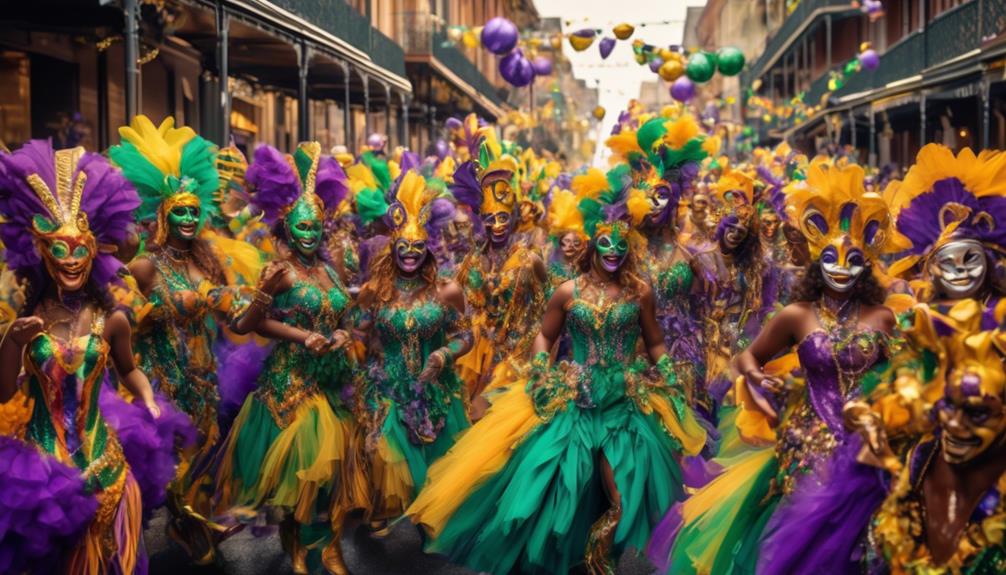
Mardi Gras, traditionally celebrated as a period of feasting before the fasting of Lent, holds religious significance for many Christians. This feast before fasting is a time-honored tradition that symbolizes the impending period of self-discipline and reflection. The significance of this pre-Lenten feasting lies in its representation of the balance between indulgence and restraint, a theme deeply rooted in religious teachings.
Here are a few aspects to consider:
- Celebration of Abundance: During Mardi Gras, the emphasis is on abundance and revelry, reflecting the joy and gratitude for the bountiful gifts bestowed by the divine. It's a time to partake in the richness of life and celebrate the blessings received.
- Camaraderie and Community: The feasting during Mardi Gras fosters a sense of togetherness and unity within the community, as people come together to share meals and festivities. This communal gathering underscores the values of fellowship and compassion, integral to religious teachings.
- Spiritual Preparation: The period of feasting before fasting serves as a spiritual preparation, allowing individuals to fully appreciate the forthcoming period of introspection and sacrifice. It provides a contrast that highlights the significance of moderation and self-discipline.
This tradition of feasting before fasting encapsulates the essence of Mardi Gras, offering a profound reminder of the religious teachings surrounding balance and spiritual readiness.
Cultural Adaptations
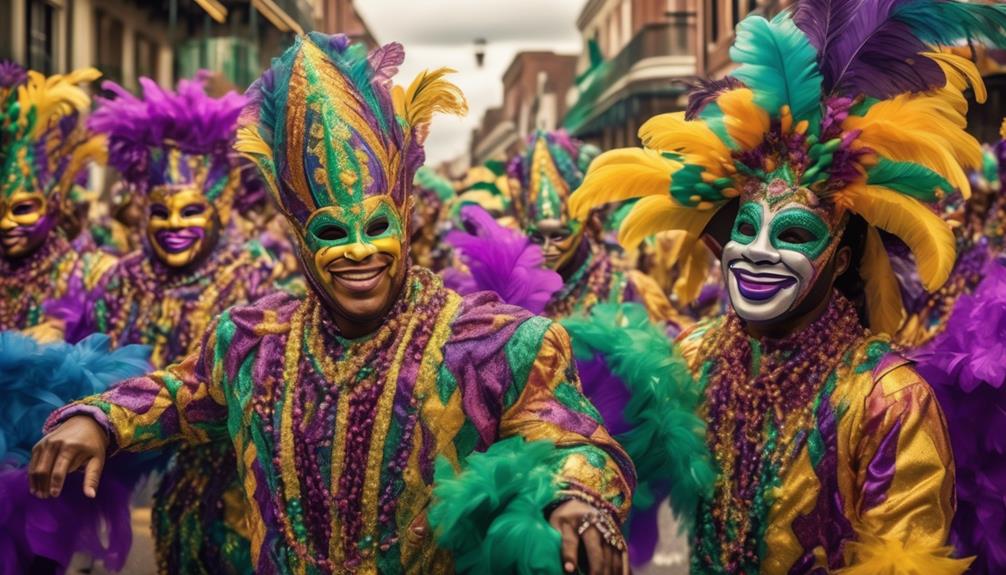
Cultural adaptations of the pre-Lenten feasting tradition surrounding Mardi Gras demonstrate the dynamic interplay between religious customs and local customs, reflecting the diverse ways in which communities have incorporated and personalized this ritual. These adaptations are influenced by a complex web of cultural factors, including historical context, geographical location, and the demographics of the community. The religious significance of Mardi Gras is often imbued with the cultural influences of the region, resulting in a rich tapestry of traditions that vary from place to place.
The cultural adaptations of Mardi Gras are a testament to the fluidity of religious practices and their ability to evolve within different societal contexts. In some regions, Mardi Gras has merged with local cultural practices, creating a unique blend of religious and secular festivities. These adaptations not only highlight the resilience of religious traditions but also underscore the importance of cultural sensitivity and inclusivity within communities.
Christian Celebrations

As we explore the religious significance of Mardi Gras, it's essential to examine the Christian celebrations that are deeply intertwined with this festive tradition.
One of the key aspects to consider is the role of Mardi Gras as a period of preparation for Lent, a time of fasting and reflection in the Christian calendar.
Additionally, understanding the historical and cultural significance of Carnival traditions within the context of Christian celebrations will provide valuable insights into the religious roots of Mardi Gras.
Lenten Preparation
Preparations for Lent involve a period of spiritual reflection and self-examination, as Christians seek to align themselves with the teachings of Jesus Christ. During this time, we engage in Lenten reflection and fasting practices, which are essential components of our preparation for the Lenten season.
Here's how we approach this period of spiritual preparation:
- Introspective Reflection: We take time to reflect on our actions, thoughts, and relationship with God, seeking to identify areas where we can grow spiritually and become more aligned with Christian principles.
- Fasting and Abstinence: We practice self-discipline through fasting and abstaining from certain luxuries, reminding ourselves of the sacrifices made by Jesus Christ and focusing on spiritual nourishment rather than material indulgence.
- Prayer and Almsgiving: We intensify our prayer life, seeking a deeper connection with God, and engage in acts of charity and giving to those in need, fostering a spirit of generosity and compassion.
Through these practices, we aim to enter the Lenten season with a renewed sense of spiritual purpose and commitment to our faith.
Carnival Traditions
Incorporating vibrant colors, lively music, and exuberant dancing, Carnival traditions are deeply rooted in the rich tapestry of Christian celebrations, marking a period of festivity and revelry before the solemn observance of Lent.
One of the most captivating aspects of Carnival is the array of elaborate carnival costumes that participants don, each outfit reflecting a unique blend of cultural influences and historical significance. These costumes, adorned with feathers, sequins, and vibrant fabrics, symbolize the joy and freedom associated with the Carnival season.
Another integral part of Carnival is the extravagant parade floats, which are meticulously crafted to depict various themes, often incorporating religious motifs and symbols. These floats, accompanied by the pulsating rhythm of marching bands, add to the immersive and jubilant atmosphere of Carnival, creating a spectacle that engages participants and observers alike.
Spiritual Reflection
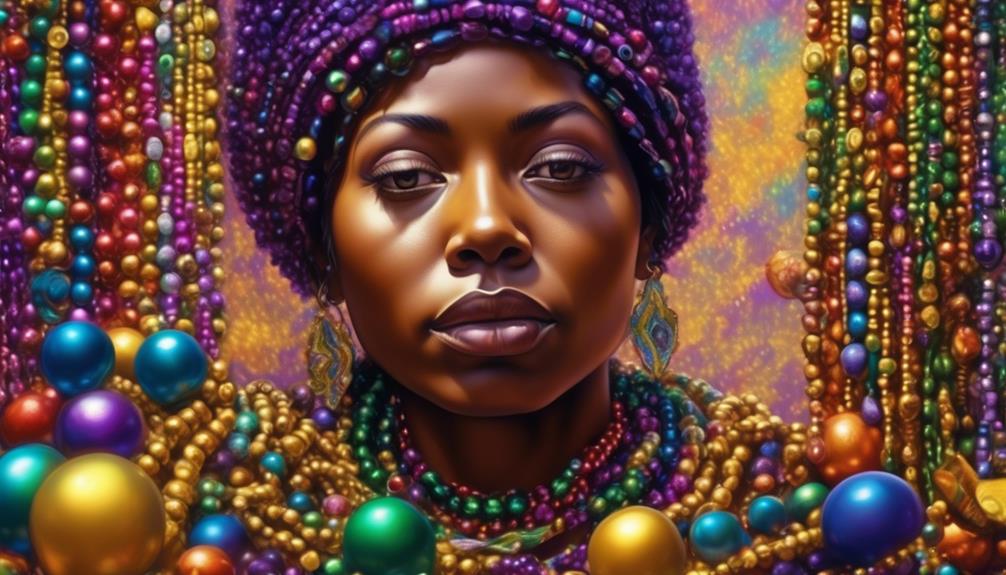
The spiritual essence of Mardi Gras permeates the experience, inviting participants to engage in profound introspection and contemplation. Embracing the meditative practice of Mardi Gras allows for spiritual growth and self-discovery.
Here are three ways in which the celebration fosters spiritual reflection:
- Community Connection: Mardi Gras brings people together in a shared celebration, fostering a sense of unity and interconnectedness. Engaging in the festivities allows individuals to reflect on their place within the community and their relationships with others.
- Symbolism and Ritual: The rich symbolism and ritualistic elements of Mardi Gras provide opportunities for deep reflection. From the vibrant colors of the costumes to the symbolic significance of the parades and floats, participants can contemplate the spiritual meanings behind these traditions.
- Renewal and Transformation: Mardi Gras is a time for renewal and transformation, both spiritually and personally. The introspective nature of the celebration encourages individuals to reflect on their own personal growth and the potential for positive change in their lives.
Engaging in these aspects of Mardi Gras can lead to a heightened sense of spiritual awareness and a deeper connection to one's inner self and the world around them.
Mardi Gras Practices

What are the traditional and contemporary practices observed during Mardi Gras celebrations, and how do they contribute to the cultural and religious significance of the event?
Mardi Gras practices encompass a rich tapestry of traditions that highlight the festive and spiritual dimensions of the celebration. One of the most iconic customs is the donning of elaborate Mardi Gras costumes. These costumes, often featuring vibrant colors and intricate designs, symbolize the temporary suspension of social norms and the embrace of revelry and merrymaking.
Additionally, the creation and display of parade floats play a pivotal role in Mardi Gras festivities. These floats, adorned with ornate decorations and thematic elements, serve as a visual representation of the diverse cultural and religious influences that shape Mardi Gras.
Furthermore, the act of participating in or observing these parades fosters a sense of community and shared celebration, reinforcing the communal aspect of this religious event. By engaging in these practices, individuals not only express their cultural identity but also reaffirm the collective spirituality that underpins Mardi Gras.
Frequently Asked Questions
How Do Different Religious Denominations Celebrate Mardi Gras?
Different religious denominations celebrate Mardi Gras with specific religious customs and cultural traditions. Each denomination adds its own unique flair to the celebration, incorporating their beliefs and practices.
These religious customs often intertwine with the cultural traditions of the local community. For example, some denominations may hold religious processions or feasts, while others may emphasize prayer and reflection.
The diverse ways in which different denominations celebrate Mardi Gras contribute to the rich tapestry of this festive occasion.
Are There Any Specific Religious Rituals or Prayers Associated With Mardi Gras?
Religious rituals associated with Mardi Gras vary among different denominations, but common practices include attending church services, participating in prayer traditions, and engaging in acts of repentance and reflection.
These rituals often serve as a way to prepare for the Lenten season and honor the religious significance of Mardi Gras.
While specific prayers may differ, the observance of religious customs and traditions remains an integral part of the celebration for many individuals and communities.
What Is the Significance of the Colors Purple, Green, and Gold in Mardi Gras Celebrations?
Symbolic colors of purple, green, and gold in Mardi Gras celebrations have deep cultural origins.
Purple represents justice, green symbolizes faith, and gold signifies power.
These traditional customs have evolved into modern interpretations, reflecting the festive spirit of Mardi Gras.
The vibrant hues are a visual feast, capturing the essence of joy and celebration that defines this colorful festival.
The vivid colors add an enchanting touch to the lively and jubilant atmosphere of Mardi Gras.
How Has Mardi Gras Been Adapted and Celebrated in Non-Christian Cultures?
Adapted celebrations of Mardi Gras have been influenced by diverse cultural traditions, resulting in unique and vibrant expressions. Cultural influences have shaped the festivities, leading to varied interpretations and practices.
These adaptations reflect the dynamic nature of Mardi Gras, showcasing the rich tapestry of global celebrations. Non-Christian cultures have embraced and integrated the spirit of Mardi Gras, bringing their own customs and rituals to create a mosaic of joyful and colorful festivities.
Are There Any Specific Religious Teachings or Lessons Associated With Mardi Gras?
Religious teachings associated with Mardi Gras vary, reflecting its cultural significance. The holiday often symbolizes the transition from indulgence to repentance, aligning with the Christian observance of Lent.
Lessons of humility, self-reflection, and the pursuit of spiritual growth are intertwined with the festivities.
Mardi Gras also holds religious significance for some as a time for communal worship and prayer.
Its unique blend of religious and cultural elements makes it a rich and complex celebration.
Conclusion
In conclusion, the religious significance of Mardi Gras is deeply rooted in Christian traditions and serves as a time of spiritual reflection and celebration before the start of Lent.
For example, many Christians around the world participate in the traditional Shrove Tuesday practices of confession and repentance before the Lenten season.
Mardi Gras continues to be a unique blend of cultural and religious observances, providing a rich tapestry of traditions and beliefs.
- About the Author
- Latest Posts
Introducing Ron, the home decor aficionado at ByRetreat, whose passion for creating beautiful and inviting spaces is at the heart of his work. With his deep knowledge of home decor and his innate sense of style, Ron brings a wealth of expertise and a keen eye for detail to the ByRetreat team.
Ron’s love for home decor goes beyond aesthetics; he understands that our surroundings play a significant role in our overall well-being and productivity. With this in mind, Ron is dedicated to transforming remote workspaces into havens of comfort, functionality, and beauty.
Mardi Gras Decoration
When Can You Put up Mardi Gras Decorations?

Timing is crucial when it comes to Mardi Gras decorations. Knowing when to put them up is key to fully embracing the festive spirit, as the old saying goes, “Timing is everything.”
But with the diverse traditions and individual preferences, it can be a challenge to determine the right time to start adorning our homes and streets with colorful masks, beads, and banners.
However, there are some key considerations that can help us navigate this decision effectively, ensuring that our Mardi Gras décor captures the essence of the celebration without overshadowing other seasonal festivities.
Key Takeaways
- Mardi Gras decorations should be put up about two weeks before Fat Tuesday.
- Traditional Mardi Gras colors such as purple, green, and gold should be used for indoor decorations.
- Indoor decorations should include masks, beads, streamers, jazz music, and scents of Cajun cuisine.
- Outdoor decorations should include colorful lights or lanterns, while being mindful of neighbors' privacy and safety.
Significance of Mardi Gras Timing
At this precise moment, we find ourselves captivated by the significance of Mardi Gras timing, as it sets the stage for the grand revelry and colorful spectacle that's to come.
The timing of the Mardi Gras festival isn't arbitrary; it's carefully calculated to ensure that the celebrations reach their peak at just the right moment. The festival's timing is intricately linked to the Christian liturgical calendar, aligning with the period before the solemnity of Lent. This strategic positioning infuses the Mardi Gras celebration with a palpable sense of urgency and excitement, as revelers seize the opportunity to indulge before the introspective period of Lent begins.
The celebration timing also plays a crucial role in shaping the overall atmosphere of the Mardi Gras festivities. The anticipation builds as the date approaches, and when the day finally arrives, the streets come alive with vibrant colors, music, and exuberant energy.
The timing creates a sense of unity and shared purpose among participants, as everyone comes together to embrace the joyous spirit of the occasion. It's this careful orchestration of timing that elevates the Mardi Gras festival from a simple event to a transformative experience.
Traditional Mardi Gras Start Date
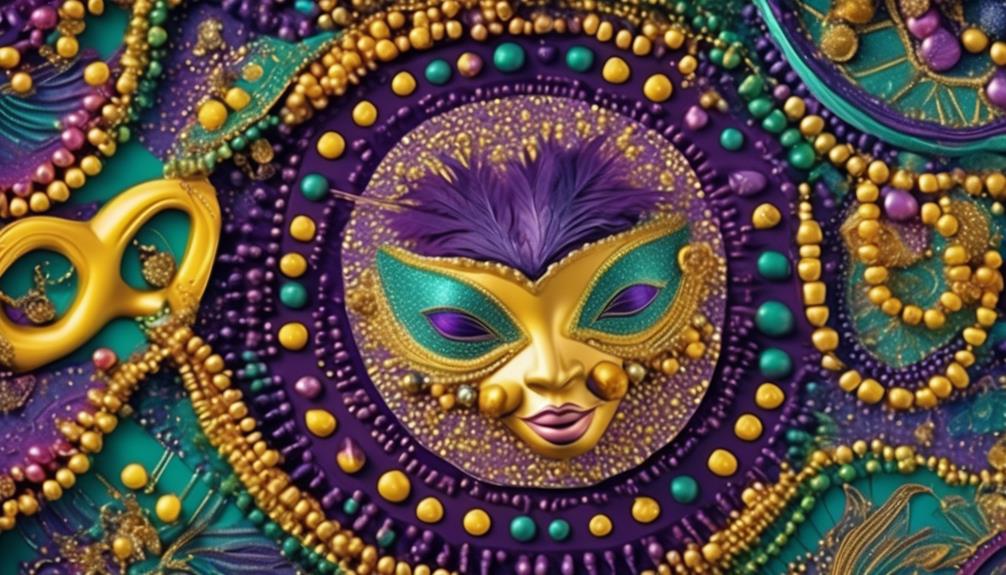
As we immerse ourselves in the vibrant tapestry of Mardi Gras traditions and festivities, the traditional start date serves as the eagerly anticipated catalyst that ignites the city in a frenzy of color, music, and jubilation. The roots of Mardi Gras history and cultural traditions intertwine with the essence of the celebration's traditional start date, creating a spectacle that captivates the soul.
On the traditional Mardi Gras start date, the city streets burst to life with a kaleidoscope of elaborate floats adorned with shimmering beads, feathers, and masks, parading through the thoroughfares. The air is infused with the irresistible aroma of Creole and Cajun cuisine, as the city's renowned culinary delights tempt the senses, inviting locals and visitors alike to partake in the feasting and revelry.
Amidst the vibrant chaos, the traditional Mardi Gras start date symbolizes the commencement of a jubilant season steeped in cultural significance, exuberant festivities, and a profound sense of community. It marks the inception of a collective journey where tradition and modernity converge, transforming the city into a living, breathing tapestry of history, culture, and celebration.
Recommended Timing for Indoor Decor
Amidst the anticipation and excitement of Mardi Gras, we find ourselves preparing to infuse our indoor spaces with the vibrant spirit of this jubilant celebration. To truly capture the essence of Mardi Gras, early preparation is key.
We recommend starting the indoor decorations about two weeks before Fat Tuesday, allowing ample time to create a festive atmosphere that will delight both residents and visitors alike.
As we dive into the world of seasonal decor, consider adorning your living spaces with traditional Mardi Gras colors – purple, green, and gold. Hang colorful masks, beads, and streamers to bring a sense of revelry into your home.
Don't forget to add a touch of New Orleans flair with jazz music playing in the background and scents of Cajun cuisine wafting through the air. These details will transport you and your guests to the heart of the French Quarter, where the Mardi Gras festivities are in full swing.
Outdoor Decorations Etiquette

With our indoor spaces adorned in the vibrant spirit of Mardi Gras, we now turn our attention to the proper etiquette for decking out our outdoor areas in celebration of this joyous occasion. When it comes to outdoor decor, it's essential to be mindful of neighborhood etiquette. Here are some tips to ensure our outdoor Mardi Gras decorations are a delightful addition to the community:
- Lighting:
We can illuminate our outdoor spaces with colorful string lights or festive lanterns to create a lively and inviting atmosphere. It's important to ensure that the brightness and placement of the lights are considerate of our neighbors' privacy and peace.
- Yard Displays:
Let's embrace the festive spirit with tasteful yard displays such as Mardi Gras-themed flags, banners, and wreaths. However, we should be mindful not to obstruct sidewalks or impede the visibility of traffic for the safety and convenience of everyone in the neighborhood.
Balancing Mardi Gras and Other Holidays
At this festive time of year, we find ourselves juggling the exuberant celebrations of Mardi Gras with the traditions of other holidays, seeking harmony in our joyful festivities. Balancing Mardi Gras and other holidays like Christmas and Easter can be a delightful challenge.
When Mardi Gras falls close to Christmas, we often blend the vibrant colors and festive spirit of Mardi Gras with the traditional Christmas decorations. It's a time when our homes come alive with the rich hues of Mardi Gras alongside the sparkle of Christmas lights, creating a magical tapestry of celebration.
As for integrating Mardi Gras with Easter, it's a time to infuse our Easter gatherings with the lively energy of Mardi Gras. This could mean incorporating Mardi Gras beads into Easter egg hunts or adding a touch of New Orleans flair to our Easter brunches. It's about embracing the joyous essence of both holidays and finding ways to merge the two into a seamless, jubilant experience.
Finding the balance between Mardi Gras and other holidays allows us to enjoy the unique traditions of each while creating a beautiful tapestry of celebrations throughout the season.
School and Workplace Decorations
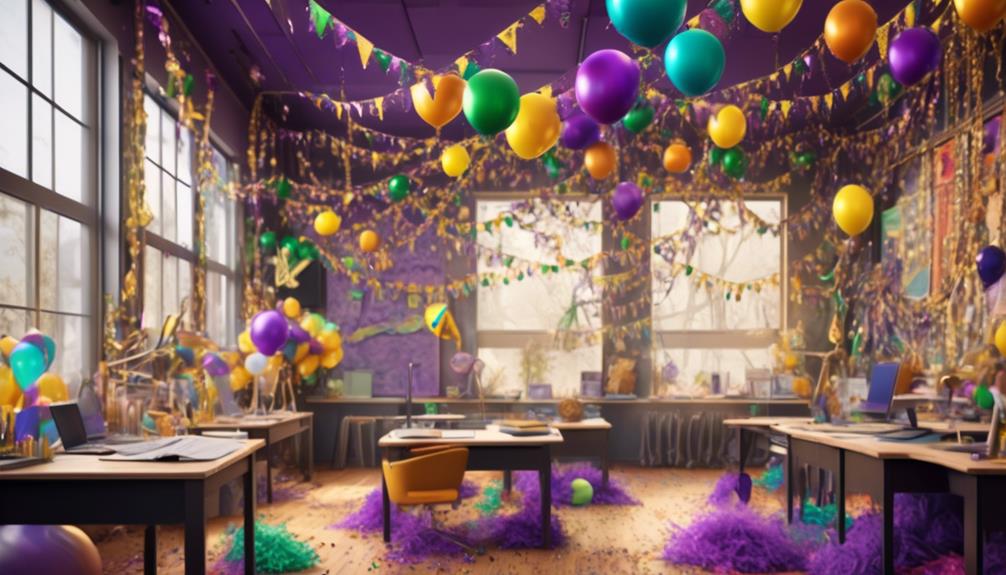
Alright, folks, let's talk about bringing the Mardi Gras spirit to our schools and workplaces!
When it comes to schools, timing is key – we want to make sure the decorations are up in time for the festivities but don't distract from important learning.
And for our workplace celebrations, we've got to keep in mind the decor rules and make sure everyone can enjoy the festive atmosphere without causing any disruptions.
Let's get ready to jazz up our schools and workplaces for Mardi Gras!
Timing for School
As we prepare for Mardi Gras at our school, it's time to plan the timing for putting up our festive decorations in classrooms and common areas. When it comes to school celebrations, holiday timing is crucial for creating an exciting and vibrant atmosphere.
Here's how we approach the timing for putting up Mardi Gras decorations at our school:
- Week Before Mardi Gras:
- Teachers and students work together to create handmade masks and colorful banners to adorn the hallways, fostering a sense of community and creativity.
- Each classroom designates a day to decorate their doors with traditional Mardi Gras colors, bringing a festive spirit to every corner of the school.
Decor Rules at Work
We love to infuse our school and workplace with festive decorations, creating an atmosphere that reflects the spirit of the occasion. When it comes to workplace decor, office celebrations can be a fun way to boost morale and create a sense of community. However, it's essential to be mindful of decor rules in professional settings. Here's a helpful guide to ensure that your office celebrations are both enjoyable and appropriate:
| Decor Element | Guidelines | Reasoning |
|---|---|---|
| Lights and Streamers | Use in designated areas and avoid blocking walkways | Prevent safety hazards and maintain accessibility |
| Themed Displays | Keep them professional and respectful | Ensure decor aligns with the workplace environment |
| Noise Makers | Limit use to designated times and areas | Respect colleagues who may require a quieter environment |
Mardi Gras Parade Preparation
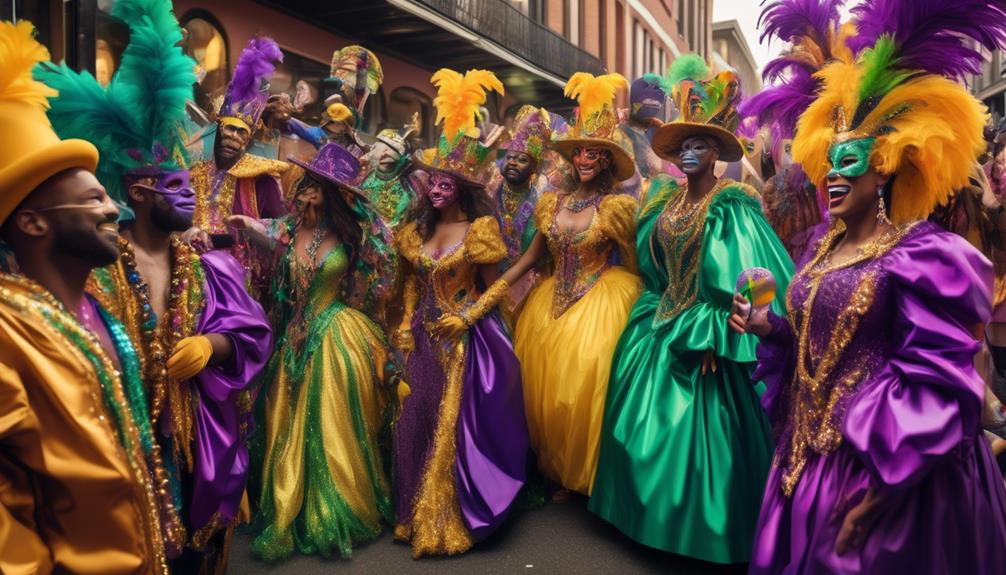
With just two weeks left until the Mardi Gras parade, our team is bustling with excitement as we prepare to bring the vibrant spirit of this celebration to life through our dazzling decorations and lively displays.
Our parade planning is in full swing, with float design taking center stage. We're envisioning majestic floats adorned with colorful feathers, shimmering sequins, and whimsical masks, each one a testament to the rich traditions of Mardi Gras.
As we delve into costume selection, we're embracing the flamboyant and extravagant, ensuring our attire reflects the opulence of this joyous event. From elaborate headdresses to elaborate masks, every detail is meticulously curated to captivate the crowd.
Simultaneously, we're coordinating our bead distribution strategy, aiming to shower the spectators with an abundance of these iconic tokens of celebration. Our beads will glisten in the sunlight, creating a spectacle of color and joy.
With each meticulous detail, we're weaving together a tapestry of excitement and wonder, ready to enchant all who gather to revel in the magic of Mardi Gras.
Hosting a Mardi Gras Party
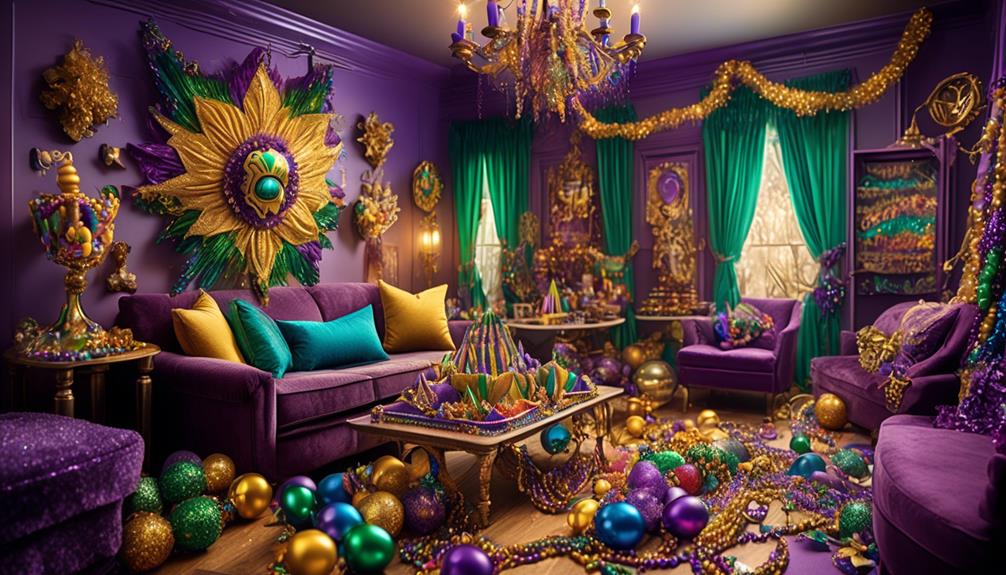
Let's talk about hosting a Mardi Gras party!
From vibrant party theme ideas to eye-catching decorations and accessories, there's so much to consider.
And of course, we can't forget about the delicious food and drinks that will truly bring the spirit of New Orleans to life.
Party Theme Ideas
Transform your Mardi Gras party into an enchanting masquerade ball.
- Costume Inspiration
- Encourage guests to wear elegant masks and vibrant, elaborate costumes reminiscent of 18th-century French aristocracy. Think feathers, sequins, and opulent fabrics, creating an atmosphere of mystery and allure.
- Consider hosting a mask-making station, providing materials for guests to craft their own unique masquerade masks, adding a personal touch to their ensembles.
- Food Menu
- Serve traditional New Orleans cuisine, such as gumbo, jambalaya, and beignets, transporting guests to the heart of the French Quarter.
- Incorporate a colorful King Cake as the centerpiece dessert, complete with traditional purple, green, and gold icing, hiding a tiny plastic baby inside for a lucky guest to find.
Immerse your guests in the magic of Mardi Gras with these enchanting party theme ideas.
Decorations and Accessories
To create an immersive Mardi Gras atmosphere, adorn your space with vibrant decorations and lavish accessories that capture the spirit of this festive celebration.
Start by illuminating your outdoor area with colorful string lights and lanterns to set the mood for an enchanting evening.
For an added touch of elegance, incorporate table centerpieces featuring traditional Mardi Gras colors like purple, green, and gold.
Consider using feathered masks, beads, and sequined fabrics as decorative elements to bring a sense of opulence to your space.
Additionally, don't forget to sprinkle glitter and confetti on tables and surfaces to enhance the festive ambiance.
Food and Drinks
As we prepare to host a Mardi Gras party, we eagerly plan a delectable spread of Cajun cuisine and vibrant cocktails to delight our guests.
Our Mardi Gras menu ideas include mouthwatering jambalaya, spicy shrimp étouffée, and crispy fried okra.
To complement these savory delights, we'll serve classic New Orleans cocktails such as refreshing Sazerac and zesty Hurricane.
For a sweet touch, we'll offer delectable beignets dusted with powdered sugar and creamy bread pudding with a rich bourbon sauce.
As for drink pairing suggestions, we recommend pairing the bold flavors of Cajun cuisine with a traditional Sazerac, and the spicy shrimp étouffée with a tangy Hurricane.
These combinations are sure to transport our guests to the heart of the French Quarter, making our Mardi Gras celebration a true culinary delight.
Mardi Gras Costume and Mask Display
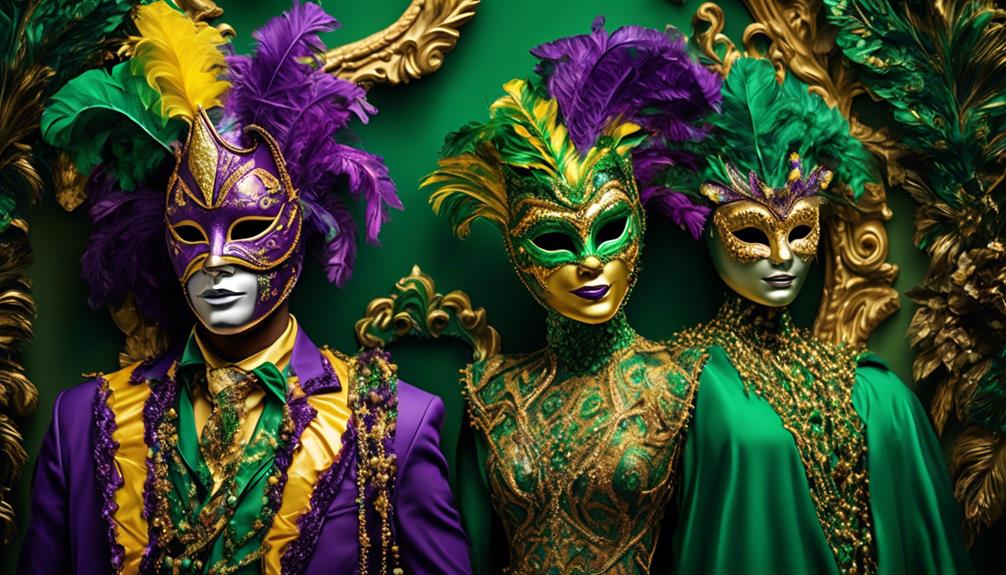
As we prepare for our Mardi Gras celebration, we eagerly assemble a vibrant and diverse array of costumes and masks to infuse our event with the spirit of revelry and mystery. The anticipation of our costume contests adds an extra layer of excitement to our preparations.
We've been hosting mask making workshops, where friends and family come together to craft elaborate and ornate masks, each one a unique expression of creativity and craftsmanship. The atmosphere is filled with laughter and joy as we share tips and techniques, all while immersing ourselves in the rich tradition of Mardi Gras mask-making.
Our costume collection is a sight to behold – from the opulent and extravagant to the quirky and whimsical, each outfit tells a story and adds to the festive atmosphere. There's an air of friendly competition as we playfully tease each other about our costume choices, all in good fun as we embrace the playful spirit of Mardi Gras.
As we gather our costumes and masks, we can't help but feel the excitement building for the big day, knowing that our carefully curated ensembles will add an extra dash of magic to our Mardi Gras celebration.
When to Take Down Decorations
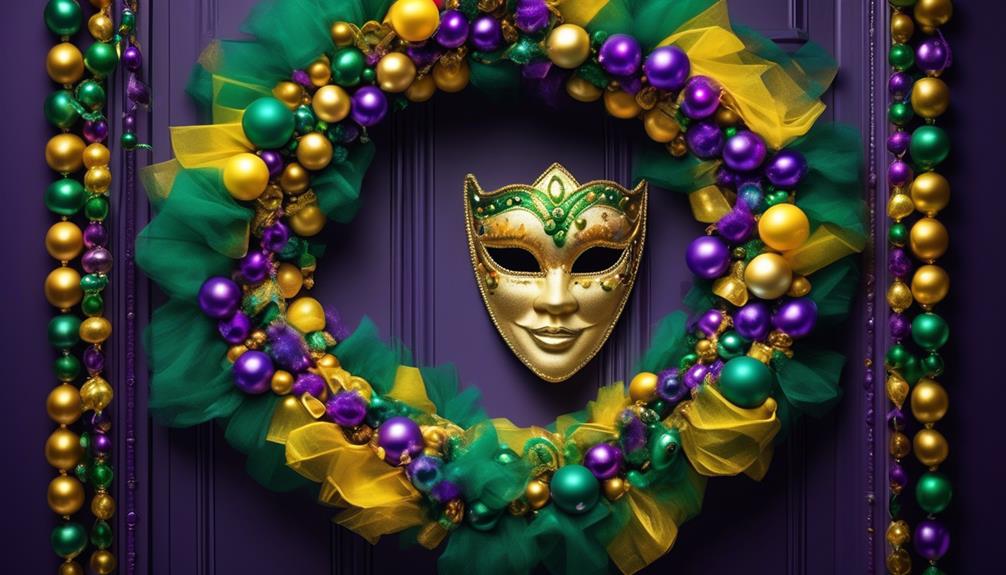
Now that the festivities have come to a close and the parades have ended, it's time to consider the timing for taking down our Mardi Gras decorations.
While the vibrant colors and flamboyant displays have added to the joyous atmosphere, it's important to also acknowledge the cultural significance of Mardi Gras and the traditions surrounding the removal of decorations.
Additionally, we can't overlook the environmental impact of leaving decorations up for too long, so it's essential to strike a balance between celebration and conservation.
Timing for Takedown
After reveling in the joyous festivities of Mardi Gras, we typically take down our decorations within a week following Fat Tuesday to ensure a smooth transition back to our everyday surroundings. When it's time to bid adieu to the vibrant colors and glittering masks adorning our homes, we approach the takedown with a sense of takedown etiquette and environmental impact in mind.
Here's how we gracefully transition from the flamboyant revelry to the serene everyday ambiance:
- Gentle Removal: We delicately remove the decorations, paying attention to minimize any environmental impact.
- *Packaging with Care*: Each glittery bauble and shimmering garland is carefully packed away, ready to bring joy next year.
As we bid farewell to the dazzling spectacle, we ensure a seamless shift back to the tranquility of our everyday surroundings while preserving the environment for future festivities.
Cultural Significance
Gently removing the decorations and packaging them with care allows us to honor the cultural significance of Mardi Gras as we determine the appropriate time to take down the vibrant adornments.
In many cultural traditions, Mardi Gras marks a period of festive celebrations leading up to the solemnity of Lent. As the season transitions, it's important to observe the customs and rituals associated with Mardi Gras. Taking down the decorations at the right time respects the heritage and meaning behind this joyous occasion.
It's a way of acknowledging the end of the lively festivities while embracing the upcoming season of reflection and spiritual renewal. By following these cultural practices, we not only maintain the essence of Mardi Gras but also prepare ourselves for the next cycle of celebration and reverence.
Environmental Impact
As we consider the environmental impact of Mardi Gras decorations, we aim to discern the ideal timing for their removal, ensuring a thoughtful and sustainable transition from the jubilant festivities to the season of reflection and renewal.
When to Take Down Decorations:
- Remove the vibrant beads and colorful streamers when they start to show signs of wear, perhaps after a few weeks of joyful display, to prevent them from becoming litter.
- Gently dismantle the elaborate float designs, preserving any reusable materials for future celebrations, while disposing of damaged components responsibly.
Last-Minute Mardi Gras Decor Tips
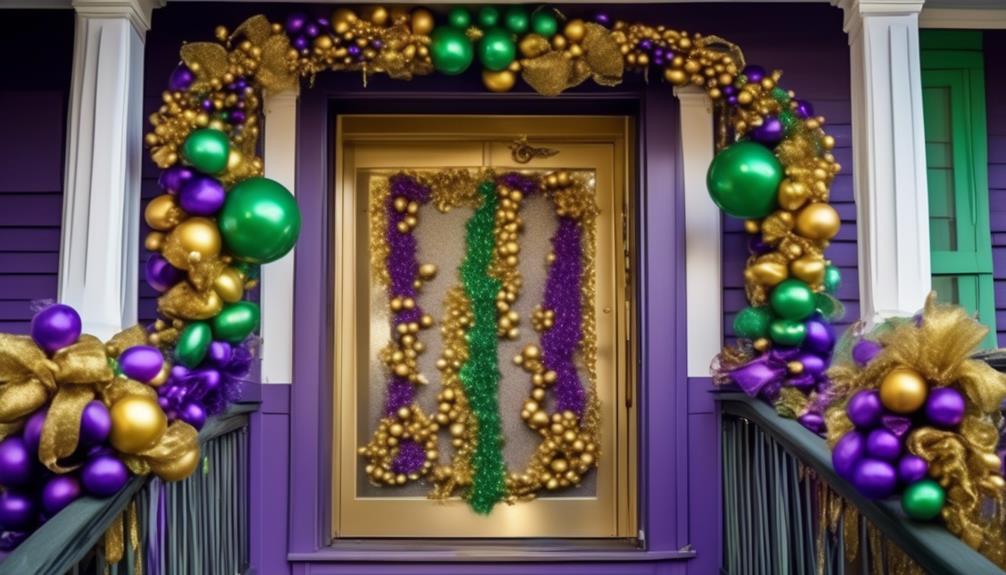
How can we quickly add a burst of Mardi Gras flair to our space to ensure a festive celebration?
With last-minute DIY decorations, we can easily infuse our surroundings with the vibrant colors of Mardi Gras. Let's start by creating festive color schemes using purple, green, and gold. Hang streamers and balloons in these colors to instantly liven up the room. Adding sparkling gold accents to table centerpieces and mantels will elevate the festive ambiance.
For a personalized touch, consider crafting your own Mardi Gras masks using simple materials like cardboard, glitter, and feathers. These can serve as both decorations and fun party favors for guests. Additionally, draping colorful beads and ribbons around doorways and furniture will contribute to the lively atmosphere.
To create a focal point, a DIY Mardi Gras wreath can be quickly put together using a grapevine base adorned with vibrant ribbons, feathers, and small masks. These simple yet effective decor tips will transform any space into a Mardi Gras celebration, ensuring a memorable and festive event for all.
Embracing Mardi Gras Spirit All Season

We immerse ourselves in the enduring jubilance of Mardi Gras, embracing its spirited essence all season long with vibrant décor and joyous festivities.
- Festive Attire
We adorn ourselves in the most extravagant costumes, donning shimmering masks and flamboyant feathers. The streets come alive with a kaleidoscope of colors as we parade in our resplendent regalia, celebrating the vivacious spirit of Mardi Gras.
- Seasonal Recipes
Indulgent king cakes, adorned with purple, green, and gold sprinkles, grace our tables, tantalizing our taste buds with the flavors of cinnamon and cream cheese. We savor the traditional Creole dishes, relishing the zesty jambalaya and savory gumbo that bring warmth to our gatherings. Each dish becomes a symbol of the rich heritage and exuberance of Mardi Gras, uniting us in a culinary celebration.
Throughout the season, our homes pulsate with the rhythm of New Orleans, as we infuse every moment with the infectious energy of Mardi Gras. With each vibrant decoration and spirited gathering, we keep the flamboyant spirit of Mardi Gras alive, ensuring that every day feels like a jubilant carnival.
Frequently Asked Questions
Can I Put up Mardi Gras Decorations in Public Spaces or on My Property?
Decorating public spaces with Mardi Gras flair is a joyful way to spread the festive spirit.
When it comes to property decoration, it's important to be mindful of local regulations to ensure safety and security.
We love adding a pop of color and celebration to our surroundings, but it's crucial to do so in a way that respects the community and maintains a festive, yet safe environment for all.
Are There Any Restrictions or Guidelines for the Types of Decorations I Can Put up for Mardi Gras?
When it comes to Mardi Gras decorations, there are various types, restrictions, and guidelines to keep in mind. From colorful outdoor banners to festive masks, we love getting creative!
While there aren't strict rules, safety and security are priorities. Bright lights, fun colors, and traditional symbols are always a hit. We ensure everyone's enjoyment while adhering to any local regulations.
Let's make our spaces vibrant and celebratory for Mardi Gras!
How Can I Make Sure My Mardi Gras Decorations Are Safe and Secure, Especially if They Are Outdoors?
Making sure our Mardi Gras decorations are safe and secure, especially if they're outdoors, is crucial. We love creating a festive atmosphere with decorative lighting, but safety is our top priority.
We always check the weatherproof rating of our outdoor lights and secure them properly to avoid any hazards. It's important to use sturdy materials and inspect our decorations regularly to ensure they stay in place and don't pose any risks.
What Are Some Unique or Creative Ways to Incorporate Mardi Gras Decorations Into My Home or Workplace?
Innovative displays and festive color schemes can truly transform any space.
One idea is to create a Mardi Gras-inspired photo backdrop using vibrant streamers and masks for a fun touch at your workplace.
At home, consider adorning doorways with glittery beads and hanging colorful garlands to bring the festive spirit indoors.
These creative touches infuse spaces with the lively energy of Mardi Gras, adding a special touch to any environment.
Are There Any Specific Cultural or Historical References I Should Consider When Choosing Mardi Gras Decorations?
When choosing Mardi Gras decorations, we consider cultural references and historical significance. It's essential to honor the traditions and heritage of this vibrant celebration.
Look for symbols like fleur-de-lis, masks, and vibrant colors that reflect the rich cultural history of Mardi Gras. Incorporating these elements into your decor not only adds authenticity but also pays homage to the diverse influences that have shaped this festive occasion.
Conclusion
Let's keep the Mardi Gras spirit alive all season long!
So, grab your beads and masks, and let's turn our homes into a Mardi Gras wonderland.
Don't be afraid to go overboard and cover every inch of the house in purple, green, and gold.
After all, when it comes to Mardi Gras decorations, more is always merrier!
Let's make every day feel like Fat Tuesday!
- About the Author
- Latest Posts
Introducing Ron, the home decor aficionado at ByRetreat, whose passion for creating beautiful and inviting spaces is at the heart of his work. With his deep knowledge of home decor and his innate sense of style, Ron brings a wealth of expertise and a keen eye for detail to the ByRetreat team.
Ron’s love for home decor goes beyond aesthetics; he understands that our surroundings play a significant role in our overall well-being and productivity. With this in mind, Ron is dedicated to transforming remote workspaces into havens of comfort, functionality, and beauty.
Mardi Gras Decoration
How Do You Make a Bulletin Board More Attractive?

We understand that enhancing the look of a bulletin board can be challenging, especially when dealing with limited space and potential clutter. However, there are a few straightforward yet impactful methods to boost the visual appeal of a bulletin board and enhance its overall attractiveness.
From choosing the right background to incorporating interactive and changeable features, there are numerous strategies that we can explore to transform a mundane bulletin board into a captivating focal point.
So, how exactly can we achieve this transformation and create a bulletin board that not only grabs attention but also serves its purpose effectively?
Key Takeaways
- Choose the right background color and texture
- Use colorful and eye-catching borders
- Incorporate various textures and materials
- Regularly update or rotate visual displays
Choose the Right Background
Choosing the right background for a bulletin board is essential to create an appealing and effective display. The background color selection plays a crucial role in determining the visual impact of the board. Bright and vibrant colors can grab attention and make the content pop, while softer pastel tones can create a more calming and inviting atmosphere. It's important to consider the purpose of the board and the emotions you want to evoke when choosing the background color.
In addition to color, the background texture also contributes to the overall aesthetic appeal of the bulletin board. Textured backgrounds can add depth and dimension to the display, making it more visually interesting. Whether it's a smooth, glossy surface or a rough, tactile texture, the background should complement the theme and content of the board.
When combining the right color and texture, the bulletin board can become an engaging focal point that draws people in and effectively communicates its message. It's amazing how such a simple element can make a world of difference in capturing attention and conveying information.
Use Colorful and Eye-Catching Borders
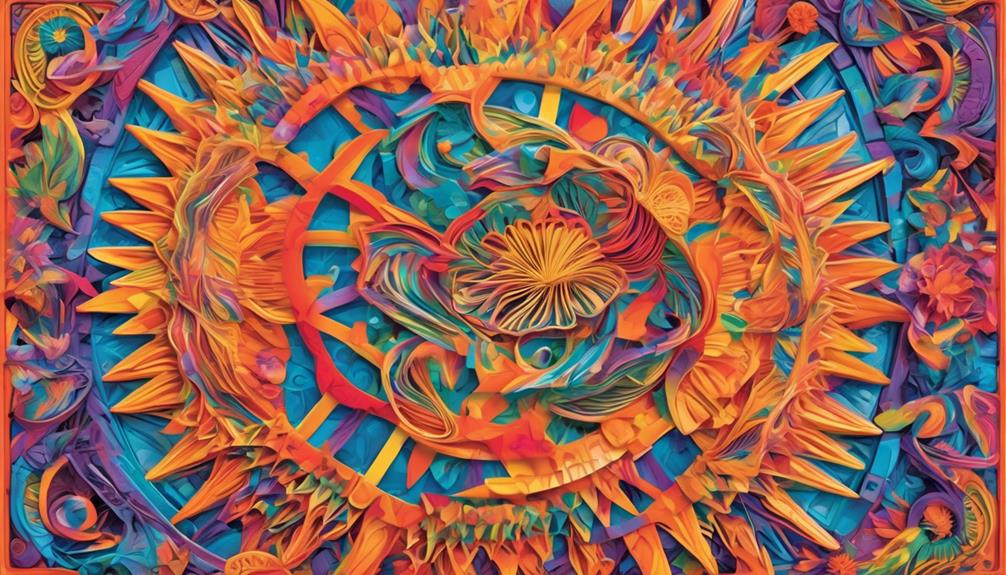
Let's talk about how the right border color can make a bulletin board pop, drawing attention and adding visual interest.
We'll also explore creative border designs that can complement the theme or purpose of the board.
Lastly, we'll share some practical tips for maintaining the borders to ensure they stay vibrant and eye-catching.
Border Color Selection
To enhance the visual appeal of a bulletin board, consider incorporating colorful and eye-catching borders to grab attention and add vibrancy to the display. When choosing border colors, it's essential to consider color psychology and pattern selection.
Here are some tips to help you select the perfect border color for your bulletin board:
- Contrast: Opt for bold, contrasting colors to make the borders stand out and draw attention.
- Complement: Choose border colors that complement the overall theme of the bulletin board to create a cohesive and visually appealing display.
- Warm or Cool Tones: Consider the mood you want to evoke and select warm or cool tones accordingly.
- Multi-color Borders: Experiment with multi-color borders to add a playful and dynamic touch to the bulletin board.
- Patterned Borders: Incorporate patterned borders to add visual interest and depth to the display.
Creative Border Designs
When creating colorful and eye-catching borders for a bulletin board, we can explore various creative designs to enhance its visual appeal.
Pattern variety adds an exciting element to the border, such as zig-zag, polka dots, or chevron patterns.
Mixing and matching materials like ribbons, washi tape, and patterned paper can create a dynamic and tactile border.
By combining different textures and shapes, we can make the border visually engaging and touchable, drawing people in to see what's on the board.
The use of contrasting colors and playful designs can also make the border stand out and complement the content displayed.
Border Maintenance Tips
Exploring creative border designs not only enhances the visual appeal of a bulletin board but also requires regular maintenance to ensure its continued attractiveness and impact. Here are some maintenance tips to keep your borders looking fresh and eye-catching:
- Regular Cleaning: Wipe the borders with a damp cloth to remove dust and dirt.
- Repair Damages Promptly: Fix any peeling or damaged parts to maintain a neat appearance.
- Seasonal Updates: Change the borders according to seasons or themes for ongoing inspiration.
- Color Touch-Ups: Keep touch-up paint handy to maintain vibrant colors and prevent fading.
- Attention to Detail: Regularly inspect the borders for any wear and tear, and make necessary touch-ups promptly.
Incorporate Various Textures and Materials

When we incorporate various textures and materials into a bulletin board, we add depth and visual interest.
By combining different textures, such as fabric, paper, and embellishments, we create a dynamic and engaging display.
This approach allows us to infuse creativity and personality into the bulletin board, making it more appealing to our audience.
Texture and Color
Incorporating various textures and materials into a bulletin board design adds visual interest and depth, making it more attractive and engaging for viewers. When considering texture and color, it's essential to understand color psychology and texture contrast to create a captivating display. Here's how we can achieve this:
- Mix and Match: Combine different textures such as fabric, paper, and wood to add dimension and tactile appeal.
- Color Combinations: Utilize color psychology to evoke specific emotions or reactions, such as using calming blues and greens or stimulating reds and oranges.
- Layering: Experiment with layering materials to create visual interest and depth, drawing the viewer in for a closer look.
- Contrast: Play with texture contrast by pairing rough and smooth materials, creating a dynamic visual impact.
- Accents: Incorporate metallic or reflective elements to enhance the overall texture and add a touch of elegance.
Visual Interest
Considering the impact of texture and color on bulletin board design, we can enhance visual interest by skillfully incorporating various textures and materials. Creative display is key to making a bulletin board visually appealing.
Mixing materials like fabric, paper, and wood can add depth and tactile interest to the display. For example, using a burlap background with colorful felt cutouts can create a dynamic and inviting visual experience. Additionally, incorporating elements such as buttons, ribbons, or natural objects like leaves and twigs can further enhance the overall texture and visual appeal of the bulletin board.
Add Dimension With Layered Elements
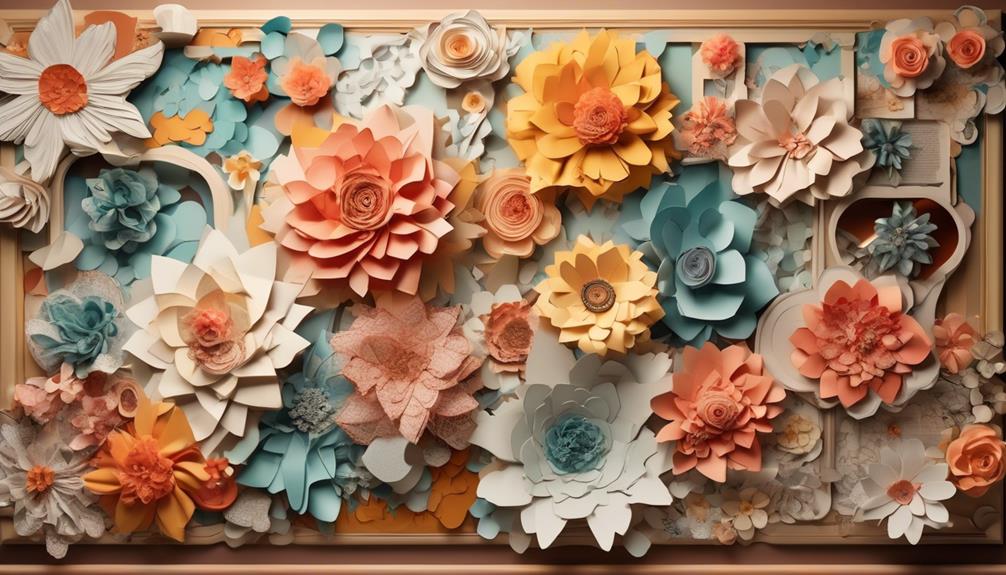
To add dimension to a bulletin board, consider using layered elements such as cutouts, borders, or raised accents. Dimensional layering adds depth and visual interest to the design composition, making the bulletin board more attractive and engaging.
Here are some ideas to enhance the visual impact:
- Cutouts: Utilize die-cut shapes or letters to create a layered effect. For example, layer a smaller cutout on top of a larger one to add depth and dimension.
- Borders: Incorporate borders made of different materials such as fabric, washi tape, or ribbon. Layering borders can frame the board and draw attention to specific content.
- Raised Accents: Use foam adhesive or double-sided tape to add raised accents like stickers, embellishments, or small objects. By layering these elements, you can create a tactile and visually interesting display.
- Mixed Media: Combine various materials like paper, fabric, and wood to create a multi-dimensional look. Layering different textures and finishes adds richness and complexity to the overall design.
- Shadowing: Experiment with shadowing techniques by layering elements at varying distances from the board. This creates a sense of depth and movement, making the bulletin board more dynamic.
These layered elements can transform a standard bulletin board into a captivating and visually appealing focal point.
Integrate Creative and Functional Organization

Let's explore how we can infuse both creativity and practicality into the organization of the bulletin board.
Functional storage is key to keeping the board tidy and efficient. Consider using baskets, shelves, or pockets to store supplies like markers, push pins, and sticky notes. This not only keeps things organized but also adds a decorative touch.
Utilizing creative display techniques can also enhance the functionality of the bulletin board. Try incorporating a calendar, to-do list, or a section for important documents. You can use colorful washi tape to create sections or borders, making the board visually appealing while also providing clear organization.
Another idea is to use clipboards or magnetic boards to display papers or notes that need to be easily accessible.
Showcase Engaging Visual Content

We've established the importance of integrating creative and functional organization to enhance the bulletin board, and now we'll focus on showcasing engaging visual content that captivates the viewers' attention and serves a dual purpose of both aesthetic appeal and informational value.
- Visual storytelling: Incorporate images, infographics, and illustrations to visually convey messages and narratives, making the content more engaging and memorable.
- Interactive engagement: Utilize interactive elements such as QR codes, pull-out tabs, or tactile materials to encourage viewers to actively participate and explore the information displayed.
- Varied textures and materials: Enhance visual interest by incorporating diverse textures and materials like fabric, wood, or metal to add depth and dimension to the bulletin board.
- Bright colors and contrasting elements: Use vibrant colors and contrasting elements to draw attention and create visual impact, making the content stand out and be easily noticeable.
- Rotating or changing displays: Keep the content fresh and engaging by regularly updating or rotating the visual displays, ensuring that viewers remain intrigued and interested in the bulletin board.
Utilize Interactive and Changeable Features

Embracing interactive and changeable features on a bulletin board ensures active engagement and dynamic information presentation. Interactive elements, such as QR codes linked to additional resources or interactive quizzes related to the displayed content, can pique viewers' interest and encourage them to participate in the learning process. Changeable displays, such as Velcro-backed posters or interchangeable sections, allow for easy updates and customization, keeping the content fresh and relevant. These features not only make the bulletin board visually appealing but also foster a sense of involvement and interactivity among the audience.
Furthermore, incorporating elements like flip cards, sliding panels, or rotating displays adds a tactile dimension to the board, inviting viewers to physically interact with the information. This hands-on approach can enhance the overall experience and make the content more memorable. By leveraging these interactive and changeable features, we create an immersive and dynamic environment that captures attention and encourages ongoing engagement.
It's all about making the bulletin board a living, evolving entity that sparks curiosity and invites active participation.
Introduce Personalization and Customization

Let's make our bulletin board more personal and unique by incorporating student work. By personalizing and customizing the board to reflect the interests and achievements of the students, we can create a more engaging and visually appealing display. Adding pops of color and texture will further enhance the aesthetic appeal.
Additionally, seeking input from the students will foster a sense of ownership and pride. By involving them in the process, we can ensure that the bulletin board truly represents their interests and accomplishments.
Use Student Work
Using student work to personalize and customize a bulletin board can make it more engaging and relatable for the entire school community.
When we incorporate student collaboration, the bulletin board becomes a reflection of our collective efforts and achievements. It fosters a sense of pride and belonging among students, teachers, and parents.
Project displays showcase the diverse talents and creativity within our school, inspiring others to contribute and participate. Seeing their own work featured on the bulletin board encourages students to take ownership of their learning environment, promoting a positive and inclusive school culture.
Additionally, it provides an opportunity for everyone to celebrate the unique perspectives and contributions of each individual, creating a vibrant and dynamic display that truly represents our school community.
Add Color and Texture
Incorporating vibrant colors and diverse textures not only enhances the appeal of the bulletin board but also introduces personalization and customization, further engaging the school community.
Colorful patterns add a dynamic and lively touch to the display, drawing attention and sparking interest.
Utilizing textured backgrounds provides depth and dimension, creating a tactile experience for viewers. By mixing and matching various textures, such as fabric, paper, and 3D elements, we can create a visually stimulating and interactive board.
The use of bright, bold colors combined with different textures can evoke different emotions and set the tone for the board, whether it's cheerful and energetic or calming and introspective.
This personalized approach fosters a sense of ownership and belonging within the school community, making the bulletin board a true reflection of our unique identity and spirit.
Incorporate Student Input
Student input plays a crucial role in personalizing and customizing the bulletin board to reflect the unique identity and interests of our school community. Our approach to incorporating student input involves true collaboration and design feedback, ensuring that the bulletin board is a true reflection of our collective identity. Here's how we do it:
- Brainstorming Sessions: We gather students to share their ideas and suggestions for the bulletin board.
- Design Contests: Students participate in design contests where they can submit their creative ideas for the board.
- Interactive Surveys: We conduct surveys to gather opinions on themes, colors, and content preferences.
- Student Showcases: Students are given the opportunity to showcase their work and interests on the bulletin board.
- Regular Feedback Loops: We maintain open channels for ongoing feedback and suggestions from students.
This collaborative approach ensures that the bulletin board truly represents our diverse and dynamic school community.
Implement Thematic and Seasonal Decor
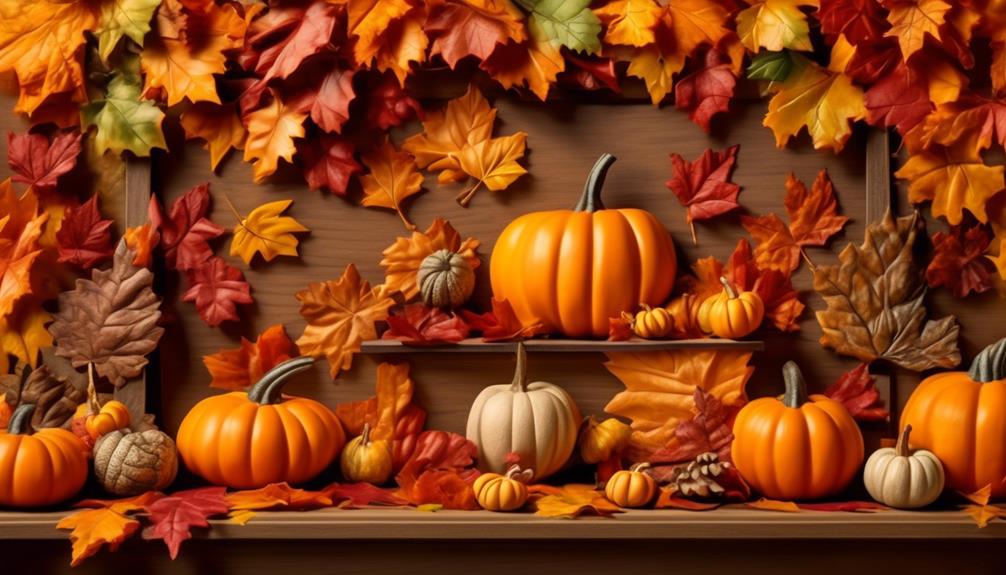
Decorating a bulletin board with thematic and seasonal elements can instantly capture attention and create an inviting atmosphere. Seasonal themes like autumn leaves, snowflakes, or blooming flowers can add a pop of color and bring the spirit of the season indoors. Incorporating decorative accents such as mini pumpkins for fall, paper snowflakes for winter, or sunflowers for summer can infuse the board with a lively and engaging feel. When we change the decor to match the time of year, it shows that we're tuned in to the world around us and helps create a sense of connection and community.
Thematic decor can also tie in with classroom lessons or school events, making the bulletin board not only attractive but also educational and relevant. For example, during Black History Month, we can feature influential figures and their achievements. This not only adds visual interest but also sparks important conversations.
Employ Lighting and Display Techniques
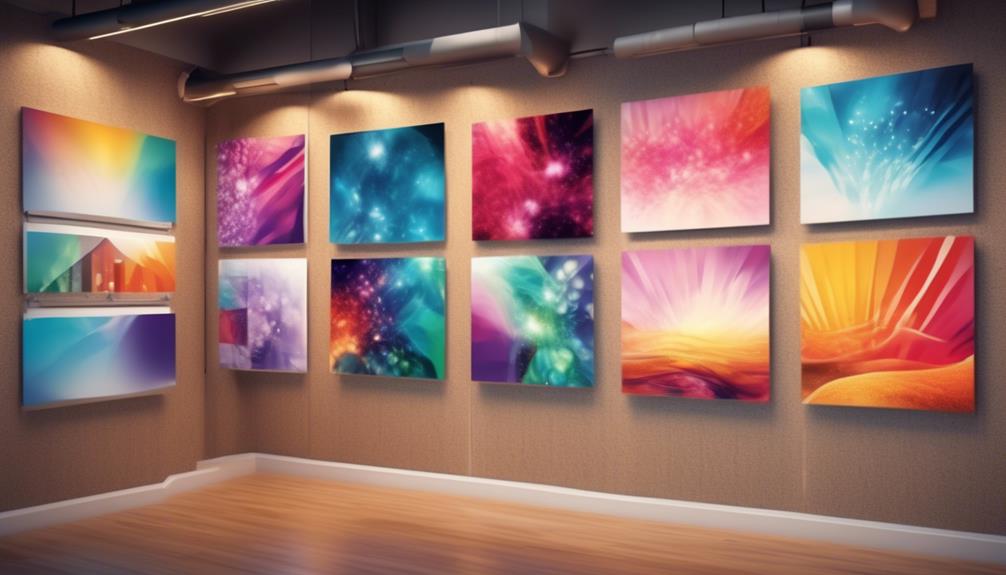
Using strategic lighting and display techniques can enhance the appeal and visual impact of a bulletin board, drawing attention and creating a dynamic focal point within the classroom. When considering lighting placement and display arrangement, it's essential to create an inviting and engaging atmosphere that encourages students to interact with the board.
Here are some tips to achieve this:
- Accent Lighting: Position spotlights or track lighting to illuminate specific areas of the bulletin board, highlighting important information and creating visual interest.
- Natural Light: Take advantage of natural light by positioning the bulletin board near windows to enhance visibility and create a vibrant display.
- Layered Display: Incorporate depth and dimension by layering materials such as fabric, paper, and 3D objects to add texture and visual intrigue.
- Interactive Elements: Integrate interactive elements such as flip cards, pull tabs, or movable pieces to engage students and encourage participation.
- Thematic Arrangement: Organize the display to tell a story or convey information in a logical and visually appealing sequence, guiding viewers through the content.
Frequently Asked Questions
How Can I Incorporate Technology or Digital Displays Into My Bulletin Board Design?
Incorporating technology and digital displays into a bulletin board design can enhance digital engagement and foster interactive learning. By integrating interactive elements like QR codes, touchscreens, or digital content, we can create a dynamic and engaging experience for our audience.
This approach not only modernizes the traditional bulletin board but also provides an opportunity for deeper and more immersive learning experiences. It's an exciting way to make information more accessible and engaging.
Are There Any Special Considerations for Making a Bulletin Board Accessible for Individuals With Visual Impairments?
When making our bulletin board accessible for individuals with visual impairments, we focus on inclusive materials and accessible design.
It's essential to consider using tactile elements, such as braille or raised textures, and high-contrast colors to enhance readability.
We aim to create an inclusive environment where everyone can engage with the information presented.
What Are Some Creative Ways to Incorporate Interactive Elements, Such as Games or Puzzles, Into a Bulletin Board?
Incorporating interactive elements like puzzle challenges and game-based learning can really spice up a bulletin board.
We could use interactive storytelling to engage viewers and encourage artistic collaboration.
By creating a platform for participation, we can make the bulletin board a dynamic and fun learning environment.
This approach not only makes the board more attractive, but also encourages active involvement and creativity from the audience.
How Can I Make My Bulletin Board More Environmentally Friendly or Sustainable?
Upcycling materials and using eco-friendly decorations are great ways to make our bulletin board more environmentally friendly and sustainable.
It's important to consider the impact of our choices on the planet. We can use old magazines or newspapers for colorful backgrounds, or repurpose old fabric for borders.
Adding potted plants or small succulents as decor not only looks great but also promotes a green atmosphere.
Are There Any Legal or Ethical Considerations to Keep in Mind When Displaying Certain Types of Content on a Bulletin Board, Such as Copyrighted Material or Sensitive Information?
Legal implications and ethical considerations are crucial when displaying content on a bulletin board. We need to ensure that we're not infringing on any copyrights or sharing sensitive information. It's important to respect intellectual property rights and privacy.
We must be mindful of the impact our content may have on others. By being respectful and responsible, we can create a welcoming and inclusive bulletin board environment for everyone.
Conclusion
In conclusion, creating an attractive bulletin board is all about being creative and using the right techniques.
As the saying goes, 'You never get a second chance to make a first impression.' So, make sure to choose the right background, use colorful borders, add dimension, and incorporate interactive features to make your bulletin board stand out.
Remember, a well-designed bulletin board can make a big impact and leave a lasting impression on your audience.
- About the Author
- Latest Posts
Introducing Ron, the home decor aficionado at ByRetreat, whose passion for creating beautiful and inviting spaces is at the heart of his work. With his deep knowledge of home decor and his innate sense of style, Ron brings a wealth of expertise and a keen eye for detail to the ByRetreat team.
Ron’s love for home decor goes beyond aesthetics; he understands that our surroundings play a significant role in our overall well-being and productivity. With this in mind, Ron is dedicated to transforming remote workspaces into havens of comfort, functionality, and beauty.
-

 Vetted4 weeks ago
Vetted4 weeks ago15 Best Contact Paper for Kitchen Cabinets to Elevate Your Home Decor
-

 Vetted3 weeks ago
Vetted3 weeks ago15 Best Poe Cameras for Home Security – Reviews & Buying Guide
-

 Vetted4 weeks ago
Vetted4 weeks ago15 Best Drain Snakes to Unclog Your Pipes Like a Pro
-

 Beginners Guides1 week ago
Beginners Guides1 week agoI Inhaled Vinegar Fumes
-

 Beginners Guides3 weeks ago
Beginners Guides3 weeks agoSwinger Porch Light Color
-

 Mardi Gras Decoration4 weeks ago
Mardi Gras Decoration4 weeks agoWhy Does Hobby Lobby Not Do Mardi Gras?
-

 Vetted18 hours ago
Vetted18 hours ago15 Best Hot Tubs of 2024: Luxurious Relaxation at Your Fingertips
-

 Vetted2 weeks ago
Vetted2 weeks ago15 Best Blinds for Bathroom Windows to Enhance Privacy and Style























![Best Nautical Bathroom Accessories for a Seafaring Home [2024] 366 81qrq833mjL](https://byretreat.com/wp-content/uploads/2023/11/81qrq833mjL-80x80.jpg)